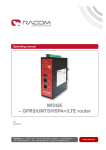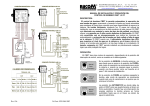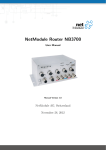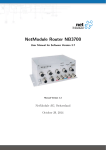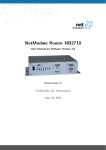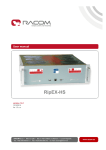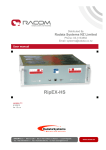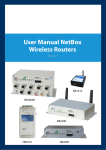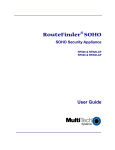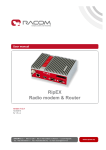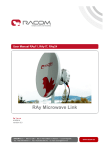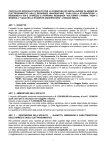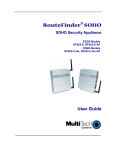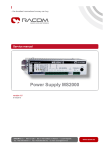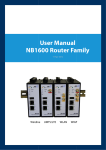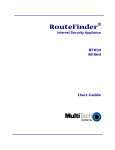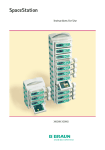Download M!DGEGPRS/UMTS/HSPA/LTE router
Transcript
Operating manual . M!DGE GPRS/UMTS/HSPA/LTE router . 1.3 6/25/2013 RACOM s.r.o. • Mirova 1283 • 592 31 Nove Mesto na Morave • Czech Republic Tel.: +420 565 659 511 • Fax: +420 565 659 512 • E-mail: [email protected] www.racom.eu Table of Contents Important Notice .................................................................................................................................. 5 Getting started ..................................................................................................................................... 6 1. M!DGE router .................................................................................................................................. 7 1.1. Introduction ........................................................................................................................... 7 1.2. Key Features ........................................................................................................................ 7 1.3. Standards ............................................................................................................................. 8 2. M!DGE in detail ............................................................................................................................... 9 3. Implementation Notes ................................................................................................................... 11 3.1. Ethernet SCADA protocols ................................................................................................. 11 3.2. Serial SCADA protocols ..................................................................................................... 11 3.3. Centre of the network ......................................................................................................... 11 3.4. VPN tunnels ....................................................................................................................... 11 4. Product .......................................................................................................................................... 12 4.1. Dimensions ......................................................................................................................... 12 4.2. Connectors ......................................................................................................................... 12 4.3. Indication LEDs .................................................................................................................. 15 4.4. Technical specifications ...................................................................................................... 17 4.5. Model offerings ................................................................................................................... 19 4.6. Accessories ........................................................................................................................ 19 5. Bench test / Step by Step Guide ................................................................................................... 21 5.1. Connecting the hardware ................................................................................................... 21 5.2. Powering up your M!DGE ................................................................................................... 21 5.3. Connecting M!DGE to a programming PC ......................................................................... 21 5.4. Basic Setup ........................................................................................................................ 22 6. Installation ..................................................................................................................................... 23 6.1. Mounting ............................................................................................................................. 23 6.2. Antenna mounting .............................................................................................................. 23 6.3. Grounding ........................................................................................................................... 23 6.4. Power Supply ..................................................................................................................... 23 7. Web Configuration ......................................................................................................................... 24 7.1. HOME ................................................................................................................................. 24 7.2. INTERFACES ..................................................................................................................... 25 7.3. ROUTING ........................................................................................................................... 38 7.4. FIREWALL .......................................................................................................................... 42 7.5. VPN .................................................................................................................................... 46 7.6. SERVICES ......................................................................................................................... 54 7.7. SYSTEM ............................................................................................................................. 77 7.8. LOGOUT ............................................................................................................................ 93 8. Command Line Interface ............................................................................................................... 94 8.1. General Usage ................................................................................................................... 94 8.2. Print Help ............................................................................................................................ 95 8.3. Getting Config Parameters ................................................................................................. 96 8.4. Setting Config Parameters ................................................................................................. 96 8.5. Getting Status Information .................................................................................................. 96 8.6. Sending E-Mail or SMS ...................................................................................................... 97 8.7. Updating System Facilities ................................................................................................. 98 8.8. Restarting Services ............................................................................................................ 98 8.9. Resetting System ............................................................................................................... 99 8.10. Rebooting System ............................................................................................................ 99 8.11. Running Shell Commands ................................................................................................ 99 8.12. CLI–PHP .......................................................................................................................... 99 © RACOM s.r.o. – M!DGEGPRS/UMTS/HSPA/LTE router 3 M!DGE GPRS/UMTS/HSPA/LTE router 9. Troubleshooting ........................................................................................................................... 103 9.1. Common Errors ................................................................................................................ 103 9.2. Messages ......................................................................................................................... 103 9.3. Troubleshooting tools ....................................................................................................... 104 10. Safety, environment, licensing ................................................................................................... 105 10.1. Safety Instructions .......................................................................................................... 105 10.2. Warranty ......................................................................................................................... 106 A. Glossary ...................................................................................................................................... 107 Index ................................................................................................................................................ 109 B. Revision History .......................................................................................................................... 111 List of Figures 1. Router M!DGE UMTS and M!DGE LTE .......................................................................................... 6 2.1. Front panel and terminal panel of M!DGE .................................................................................... 9 4.1. Dimensions in milimetres ........................................................................................................... 12 4.2. Antenna connectors SMA ........................................................................................................... 12 4.3. 2× Eth RJ45 Plug - pin numbering ............................................................................................. 13 4.4. USB connector ........................................................................................................................... 13 4.5. Screw terminal ............................................................................................................................ 14 4.6. Indication LEDs .......................................................................................................................... 15 4.7. Flat bracket ................................................................................................................................. 19 4.8. Demo case ................................................................................................................................. 20 6.1. Grounding ................................................................................................................................... 23 List of Tables 4.1. Pin assignment Ethernet Interface ............................................................................................. 13 4.2. USB pin description .................................................................................................................... 13 4.3. Pin assignment of screw terminal .............................................................................................. 14 4.4. Digital inputs levels ..................................................................................................................... 14 4.5. Digital outputs parametres ......................................................................................................... 14 4.6. M!DGEs interfaces and status indicators ................................................................................... 16 4.7. Technical specifications .............................................................................................................. 18 4 M!DGEGPRS/UMTS/HSPA/LTE router – © RACOM s.r.o. Important Notice Important Notice Copyright © 2013 RACOM. All rights reserved. Products offered may contain software proprietary to RACOM s. r. o. (further referred to under the abbreviated name RACOM). The offer of supply of these products and services does not include or infer any transfer of ownership. No part of the documentation or information supplied may be divulged to any third party without the express written consent of RACOM. Disclaimer Although every precaution has been taken in preparing this information, RACOM assumes no liability for errors and omissions, or any damages resulting from the use of this information. This document or the equipment may be modified without notice, in the interests of improving the product. Trademark All trademarks and product names are the property of their respective owners. Important Notice • • • Due to the nature of wireless communications, transmission and reception of data can never be guaranteed. Data may be delayed, corrupted (i.e., have errors), or be totally lost. Significant delays or losses of data are rare when wireless devices such as the M!DGE are used in an appropriate manner within a well‐constructed network. M!DGE should not be used in situations where failure to transmit or receive data could result in damage of any kind to the user or any other party, including but not limited to personal injury, death, or loss of property. RACOM accepts no liability for damages of any kind resulting from delays or errors in data transmitted or received using M!DGE, or for the failure of M!DGE to transmit or receive such data. Under no circumstances is RACOM or any other company or person responsible for incidental, accidental or related damage arising as a result of the use of this product. RACOM does not provide the user with any form of guarantee containing assurance of the suitability and applicability for its application. RACOM products are not developed, designed or tested for use in applications which may directly affect health and/or life functions of humans or animals, nor to be a component of similarly important systems, and RACOM does not provide any guarantee when company products are used in such applications. © RACOM s.r.o. – M!DGEGPRS/UMTS/HSPA/LTE router 5 Getting started Getting started M!DGE Wireless Routers will only operate reliably over the cellular network if there is a strong signal. For many applications a flexible stub antenna would be suitable but in some circumstances it may be necessary to use a remote antenna with an extension cable to allow the antenna itself to be positioned so as to provide the best possible signal reception. RACOM can supply a range of suitable antennas. 1. 2. 3. 4. 5. 6. Install the SIM card Insert a SIM card into the SIM socket. Make sure the SIM is suitable for data transmission. Connect the GSM/UMTS antenna Fit a GSM/UMTS antenna. 1. If needed, contact RACOM for suitable antennas and other details. Connect the LAN cable Connect one M!DGE Ethernet port to your computer using an Eth cat.5 cable Connect the power supply Connect the power supply wires to the M!DGE screw terminals. Enable the power supply. Setting of IP address of the connected computer By default the DHCP server is enabled, thus you can allow the Dynamic Host Configuration Protocol (DHCP) on your computer to lease an IP address from the M!DGE. Wait aproximatelly 20 seconds until your computer has received the parameters (IP address, subnet mask, default gateway, DNS server). As an alternative. you can configure a static IP address on your PC (e.g. 192.168.1.2/24) so that it is operating in the same subnet as the M!DGE. The M!DGE default IP address for first Eth interface is 192.168.1.1, the subnet mask is 255.255.255.0. Start setting up using web browser Open a web browser such as Internet Explorer or Firefox. In the address field of the web browser, enter default IP address of M!DGE (i.e. http://192.168.1.1); initial screen will appear. Follow the instructions and use the M!DGE/MG102 Web Manager to configure the device. For more datails see chap. 7. Web Configuration Fig. 1: Router M!DGE UMTS and M!DGE LTE 6 M!DGEGPRS/UMTS/HSPA/LTE router – © RACOM s.r.o. M!DGE router 1. M!DGE router 1.1. Introduction Although M!DGE wireless routers have been specifically designed for SCADA and telemetry, they are well suited to variety of wireless applications. M!DGE HW and SW are ready to maintain reliable and secure connections from an unlimited number of remote locations to a central server. Both standard Ethernet/IP and serial interfaces are available. Moreover, two digital inputs and two digital outputs can be used for direct monitoring and control of application devices. M!DGE versatility is further enhanced by two independent Ethernet ports. These can be configured to either support two independent LANs (e.g. LAN and WAN settings), or simply connect two devices within one LAN (effectively replacing an Eth switch). M!DGE software is based on proven components, including an Embedded Linux operating system and standard TCP/IP communication protocols. Combining M!DGE with an MG102 two-SIM router in one network is quite straightforward because of fully compatible interface settings and behaviour on all HW interfaces. Thanks to the compact size and versatility of M!DGE, wireless routers prove indispensable in many SCADA and telemetry, as well as POS, ATM, lottery and security/surveillance applications. M!DGE together with RACOM RipEX radio router offers an unrivalled solution for combining GPRS and UHF/VHF licensed radio in a single network. Even a single RipEX in the centre of a M!DGE network allows for efficient use of addressed serial SCADA protocols. 1.2. Key Features Mobile Interface Parameters • • • Mobile Connection HSDPA, HSUPA, UMTS, EDGE, GPRS, GSM and LTE Global connectivity Transparent hand-over between 2G and 3G (M!DGE UMTS) or 2G, 3G and 4G (M!DGE LTE) Power supply • • • Redundant dual power input pins Input voltage: 10.2 – 57.6 VDC Max. power consumption: 5 W Services /Networking • • • • • • • • • • • Fallback Management Connection supervision Automatic connection recovery OpenVPN, IPsec, PPTP, NAPT VRRP DHCP server, DNS proxy server, DNS update agent Telnet server, SSH server, Web server NTP COM server, Modbus gateway Port Forwarding Firewall, Access Control Lists © RACOM s.r.o. – M!DGEGPRS/UMTS/HSPA/LTE router 7 M!DGE router Interfaces • • • • 2 Ethernet ports: LAN, WAN/LAN RS232 2× DI, 2× DO USB host Diagnostic and Management • • • • • • Web interface, CLI available File configuration OTA SW update Advanced troubleshooting SMS remote control, SMS and E-mail notification SNMP 1.3. Standards EMC EN 301 489-1 V1.7.1 EN 301 489-7 V1.3.1 EN 61 000-6:2005 EN 50 121-3-2:2006 EN 50 121-4:2006 Electrical Safety EN 60950-1:2006 IP rating IP40 ETH IEEE 802.3i IEEE 802.3u IEEE 802.3af 8 M!DGEGPRS/UMTS/HSPA/LTE router – © RACOM s.r.o. M!DGE in detail 2. M!DGE in detail Fig. 2.1: Front panel and terminal panel of M!DGE All M!DGE/MG102 Wireless Routers run M!DGE/MG102 Software. Software offers the following key features: • • • • • Interfaces and Connection Management (section Section 7.2, “INTERFACES”) ○ Dial-out (on demand, permanent) ○ Connection Monitoring ○ Fallback to backup profile or SIM ○ SIM and PIN management ○ Automatic or manual network selection Routing (section Section 7.3, “ROUTING”) ○ Static Routing ○ NAPT / Port Forwarding Security / Firewall (section Section 7.4, “FIREWALL”) ○ NAPT / Port Forwarding ○ Access Control Lists ○ Stateful Inspection Firewall Virtual Private Networking (VPN) (section Section 7.5, “VPN”) ○ OpenVPN Client ○ PPTP Server ○ IPsec Peer ○ Dial-in Server Services (section Section 7.6, “SERVICES” ) ○ COM Server (Tunneling of the serial line over IP) ○ Modbus-RTU to Modbus-TCP Gateway ○ DHCP Server ○ DNS Proxy Server ○ Dynamic DNS Client ○ E-mail Client ○ Notification via E-mail and SMS © RACOM s.r.o. – M!DGEGPRS/UMTS/HSPA/LTE router 9 M!DGE in detail • 10 ○ SMS Client ○ SSH Server ○ SNMP Agent ○ Telnet Server ○ Unstructured Supplementary Service Data (USSD) ○ Web Server ○ GPS Daemon (MG102-xGx only) System Administration (section Section 7.7, “SYSTEM”) ○ Configuration via Web Manager ○ Configuration via Command Line Interface (CLI) accessible via Secure Shell (SSH) and telnet ○ Batch configuration with text files ○ User admnistration ○ Troubleshooting tools ○ Over the air software update M!DGEGPRS/UMTS/HSPA/LTE router – © RACOM s.r.o. Implementation Notes 3. Implementation Notes 3.1. Ethernet SCADA protocols SCADA equipment with an Ethernet protocol behave as standard Ethernet equipment from a communications perspective . Thus the communication goes transparently through the GPRS//UMTS/LTE network. The implementation requires a heightened caution to IP addressing and routing. NAPT functionality should be used frequently. 3.2. Serial SCADA protocols A SCADA serial protocol typically uses simple 8 or 16 bit addressing. The mobile network address scheme is an IP network, where range is defined by service provider (sometimes including individual addresses, even in the case of a private APN). Consequently, a mechanism of translation between SCADA and the IP addresses is required. To make matters worse, IP addresses may be assigned to GPRS (EDGE, UMTS, etc.) devices dynamically upon each connection. 1 Please read the application note SCADA applications and M!DGE/MG102 which describes how to efficiently solve this problem using RACOM routers. 3.3. Centre of the network In every network, the centre plays a key role and has to be designed according to customer's requirements. Several possible solutions are described in the application note M!DGE/MG102 CENTRE – 2 Application note . 3.4. VPN tunnels security of customer's data arriving through the mobile network is often very important. Private APN is the basic security requirement, but not safe enough for such applications. VPN tunnels solution is closely connected with the centre. The solution is mentioned in application note 3 M!DGE/MG102 CENTRE – Application note , details for the elemental solution are described in the 4 application note SCADA applications and M!DGE/MG102 . 1 http://hnilux.racom.cz:3004/download/hw/midge/free/cz/midge-app-en.pdf http://hnilux.racom.cz:3004/download/hw/midge/free/cz/midge-app-en1.pdf 3 http://hnilux.racom.cz:3004/download/hw/midge/free/cz/midge-app-en1.pdf 4 http://hnilux.racom.cz:3004/download/hw/midge/free/cz/midge-app-en.pdf 2 © RACOM s.r.o. – M!DGEGPRS/UMTS/HSPA/LTE router 11 Product 4. Product 4.1. Dimensions Fig. 4.1: Dimensions in milimetres 4.2. Connectors 4.2.1. Antenna SMA The UMTS model has one SMA antenna connector. The LTE model is equipped with two antenna connectors. The ANT connector (above) serves as a main antenna connection, the second connector is auxiliary and serves for better communication with BTS (diversity). Fig. 4.2: Antenna connectors SMA 12 M!DGEGPRS/UMTS/HSPA/LTE router – © RACOM s.r.o. Product 4.2.2. 2× Eth RJ45 Tab. 4.1: Pin assignment Ethernet Interface RJ-45 Socket ETH (Ethernet 10BaseT and 100BaseT) pin signal 1 TX+ 2 TX− 3 RX+ 6 RX− Fig. 4.3: 2× Eth RJ45 Plug - pin numbering 4.2.3. USB M!dge uses USB 1.1, Host A interface. USB interface is wired as standard: Tab. 4.2: USB pin description USB pin signal wire 1 +5 V red 2 Data(−) white 3 Data (+) green 4 GND black Fig. 4.4: USB connector 4.2.4. Screw terminal Screw terminal plug type Stelvio Kontek CPF5/15 or MRT3P/15V01 can be used. © RACOM s.r.o. – M!DGEGPRS/UMTS/HSPA/LTE router 13 Product Fig. 4.5: Screw terminal Tab. 4.3: Pin assignment of screw terminal pin pin description 1 VGND 2 V+ (12–48 V=) 3 4 VGND V+ (12–48 V=) signal Ground internally connected with casing ground Dual power input - not connected with pin 4: 12–48 VDC (–15% +20%) = 10.2–57.6 VDC Ground internally connected with casing ground Dual power input– not connected with pin 2: 12–48 VDC (–15 % +20 %) = 10.2–57.6 VDC. 5 RxD RS232 – RxD 6 TxD RS232 – RxD 7 GND RS232 – RxD DO1: Digital output. Dry contact relay. Normally open with M!DGE without powering DO2: Digital output. Dry contact relay. Normally open with M!DGE without powering. See section Section 7.2.6, “Digital I/O” for detailes. 12 DI1− Digital input 1 See section Section 7.2.6, “Digital I/O” 13 DI1+ Digital input 1 14 DI2− Digital input 2 15 DI2+ Digital input 2 8 9 10 11 Tab. 4.4: Digital inputs levels logical level 0 0 to 5.6 VDC logical level 1 7.2 to 40 VDC Note: Negative input voltage is not recognised. Tab. 4.5: Digital outputs parametres Maximal continuous current 1A Maximal switching voltage 60 VDC, 42 VAC (Vrms) Maximal switching capacity 60 W 14 M!DGEGPRS/UMTS/HSPA/LTE router – © RACOM s.r.o. Product 4.2.5. Reset button The Reset button is placed close to the screw terminal and it is labelled "Reset". Use a blunt tool with 1 mm in diameter (e.g. paper clip) to press the button. Keep it pressed for at least 3 seconds for reboot and at least 10 seconds for a factory reset. The start of the factory reset is confirmed by all LEDs lighting up for one second. The button can be released afterwards. 4.3. Indication LEDs Fig. 4.6: Indication LEDs © RACOM s.r.o. – M!DGEGPRS/UMTS/HSPA/LTE router 15 Product Tab. 4.6: M!DGEs interfaces and status indicators Label Status Connect VPN DO1 DO2 DI1 DI2 16 State Function blinking slowly Start up, maintenance solid Ready green color Right side description yellow color Left side description green on Excellent GSM signal yellow on Medium GSM signal red on Weak GSM signal red blinking Mobile interface enabled but not connected red continually Connected green on VPN connection is up green blinking VPN connection is enabled and not connected yellow on Closed yellow off Opened yellow on Closed yellow off Opened yellow on Input set yellow off Input not set yellow on Input set yellow off Input not set M!DGEGPRS/UMTS/HSPA/LTE router – © RACOM s.r.o. Product 4.4. Technical specifications © RACOM s.r.o. – M!DGEGPRS/UMTS/HSPA/LTE router 17 Product Tab. 4.7: Technical specifications Multimode HSDPA, HSUPA, UMTS, EDGE, GPRS and GSM Mobile Interface UMTS 3G–UMTS, HSDPA, HSUPA, UMTS: 850/900/1900/2100 MHz 2G–EDGE, GPRS, GSM: 850/900/1800/1900 MHz Data rates: max. 7.2 Mbps downlink / 5.76 Mbps uplink Multimode LTE, HSPA+, UMTS, EDGE, GPRS, GSM 4G–LTE: 800/900/1800/2100/2600 MHz Mobile Interface LTE 3G–UMTS/HSPA+: 900/2100 MHz 2G–GSM/GPRS/EDGE: 900/1800/1900 MHz Data rates up to 100 Mbps downlink / 50 Mbps uplink Ethernet 2× Ethernet 10/100 Base-T, Auto MDX, 2× RJ45, bridged or routed Serial Interface 1× 3-wire RS232 on 15-pin screw terminal block 0–5.6 VDC level 0 2 digital inputs 7.2–40 VDC level 1, maximum voltage 40 VDC st nd Relay outputs 1 NO, 2 Digital I/O NC Limiting continuous current 1 A 2 digital outputs Max. switching voltage 60 VDC, 42 VAC (Vrms) Maximum switching capacity 60 W on 15-pin terminal block USB service interface Antenna Interface Power Supply USB host interface supporting memory devices USB type A connector Impedance: 50 Ω Connector: SMA female Input voltage: 10.2–57.6 VDC (12–48 VDC –15 % / +20 %) Power consumption: Rx max. 3.2 W Tx max. 5 W For indoor use only, IP40 Metal casing, DIN rail mounting kit included Environmental Conditions Temperature range: –25 to +70 °C (–13 to +158 °F) Humidity: 0 to 95 % (non condensing) Overvoltage Category: II Pollution Degree: 2 Mounting DIN rail mounting Dimensions / Weight 125 × 45 × 110 mm, 450 g (1 lbs) Type Approval CE, R&TTE (see EC Declaration of Conformity) Options Antennas Various antennas suitable for your application are available Mounting kit Flat bracket mounting kit 18 M!DGEGPRS/UMTS/HSPA/LTE router – © RACOM s.r.o. Product 4.5. Model offerings M!DGEUMTS GPRS/EDGE/UMTS/HSPA router, 2Eth, RS232, 2DI, 2DO DIN rail holder included M!DGE-LTE GPRS/EDGE/UMTS/HSPA+/LTE router, 2Eth, RS232, 2DI, 2DO DIN rail holder included SW feature keys The SW feature key should be added to a new or running system via adding a licence: menu SYSTEM - Licensing (see Section 7.7.7, “Licensing” ). Mobile IP This key allows building a MobileIP VPN tunnel. See http://en.wikipedia.org/wiki/Mobile_IP for short explanation. Server Ext. OpenVPN server extension - without this key the maximum number of connected clients shall reach 10. This key extends the number to 25. 4.6. Accessories 4.6.1. F bracket Fig. 4.7: Flat bracket Flat-bracket Installation bracket for flat mounting. For details on use see chapter Mounting and chapter Dimensions. © RACOM s.r.o. – M!DGEGPRS/UMTS/HSPA/LTE router 19 Product 4.6.2. Demo case A rugged plastic case for carrying up to three RipEX's and one M!DGE 3G SCADA router. It also contains all the accessories needed to perform an on-site signal measurement, complete application bench-test or a functional demostration of both radiomodems and the 3G router. During a field test, units can be powered from the backup battery and external antenna can be connected to one of the RipEX units through the „N“ connector on the case. Fig. 4.8: Demo case Contents: • • • • • • Brackets and cabling for installation of three RipEXes and one M!DGE (units are not part of the delivery) 1× power supply Mean Well AD-155A (100-240 V AC 50-60 Hz/13.8 V DC) 1× Backup battery (12V/5Ah, FASTON.250), e.g. Fiamm 12FGH23 1× Power cable (European Schuko CEE 7/7 to IEC 320 C13) 1× Ethernet patch cable (3 m, UTP CAT 5E, 2× RJ-45) Quick start guide RipEX accessories: • • • • 3× Dummy load antennas 1× L-bracket, 1x Flat-bracket samples 1× Fan kit 1× X5 – ETH/USB adapter M!DGE accessories: • • • 20 Whip antenna (900–2100 MHz, 2.2 dBi, vertical) Externel dimensions: 455 × 365 × 185 mm Weight approx. 4 kg (excluding RipEXes and M!DGE) M!DGEGPRS/UMTS/HSPA/LTE router – © RACOM s.r.o. Bench test / Step by Step Guide 5. Bench test / Step by Step Guide Before starting to work with the HW please be sure that you have a SIM card enabled for data and you have all the necessary information from the mobile operator (PIN, APN, login, passwd) 5.1. Connecting the hardware 5.1.1. Install the SIM card Insert a SIM card into the SIM socket. If the router has two SIM card sockets, use the first one. Make sure the SIM is suitable for data transmission. There are two reasons for installing the SIM card as the first task: a) the SIM card may be damaged when inserted into the powered equipment, b) the information from SIM card are read only after a power cycle. 5.1.2. Connect the GSM/UMTS antenna Fit a GSM/UMTS antenna. For details see section Section 4.6, “Accessories” or contact RACOM for suitable antennas. 5.1.3. Connect the LAN cable Connect one M!DGE Ethernet port to your computer using an Eth cat.5 cable. 5.1.4. Connect the power supply Connect the power supply wires to the M!DGE screw terminals. Enable of the power supply. 5.2. Powering up your M!DGE Switch on your power supply. Status LED flashes for a few seconds and after 8 seconds it starts blinking to a green light. After approximately 30 seconds your M!DGE will have booted and will be ready; the Status LED remains shining on. When the Mobile Connection is enabled the Connect LED starts blinking while connecting to the GPRS/UMTS network – the color (green/yellow/red) represents the signal strength (excellent, medium, weak). You’ll find the description of the individual LED states in Section Section 4.3, “Indication LEDs”. 5.3. Connecting M!DGE to a programming PC a. b. Please connect the Ethernet interfaces of your computer and M!DGE. If not yet enabled, please enable the Dynamic Host Configuration Protocol (DHCP) so that your computer can lease an IP address from M!DGE. Wait a moment until your PC has received the parameters (IP address, subnet mask, default gateway, DNS server). How to do using Windows XP: Start > Connect To > Show all connections > Local Area Connection > Right Click > Properties > Internet Protocol (TCP/IP) > Properties > Obtain an IP address automatically. © RACOM s.r.o. – M!DGEGPRS/UMTS/HSPA/LTE router 21 Bench test / Step by Step Guide Alternative: Instead of using the DHCP, configure a static IP address on your PC (e.g. 192.168.1.10 mask 255.255.255.0) so that it is operating in the same subnet as the M!DGE. c. d. The factory default IP address is 192.168.1.1 The default subnet mask is 255.255.255.0. Start a Web Browser on your PC. Type the M!DGE/MG102 IP address in the address bar: http://192.168.1.1 Please set a password for the admin user account. Choose something that is both easy to remember and a strong password (such as one that contains numbers, letters and punctuation). The password shall have a minimum length of 6 characters. It shall contain a minimum of 2 numbers and 2 letters. 5.4. Basic Setup The M!DGE/MG102 Web Manager can always be reached via the Ethernet interface. After successful setup, Web Manager can also be accessed via the mobile interface. Any up to date web browser may be used. Any web browser supporting JavaScript may be used. By default, IP address of the Ethernet interface is 192.168.1.1, the web server runs on port 80. The minimum configuration steps usually include: 1. 2. 3. 4. 22 Defining the admin password Entering the PIN code for the SIM card Configuring the Access Point Name (APN) Starting the mobile connection M!DGEGPRS/UMTS/HSPA/LTE router – © RACOM s.r.o. Installation 6. Installation 6.1. Mounting M!DGE Wireless Router is designed for a DIN rail mounting or on a panel using flat bracket. Please consider the safety instructions in Chapter 10, Safety, environment, licensing. 6.2. Antenna mounting M!DGE Wireless Routers will only operate reliably over the GSM network if there is a strong signal. For many applications the flexible stub antenna provided would be suitable but in some circumstances it may be necessary to use a remote antenna with an extended cable to allow the antenna itself to be positioned so as to provide the best possible signal reception. RACOM can supply a range of suitable antennas. Beware of the eflective effects caused by large metal surfaces (elevators, machine housings, etc.), close meshed iron constructions and choose the antenna location accordingly. Fit the antenna or connect the antenna cable to the GSM antenna connector. In external antennas the surge protection of coaxial connection would be required. Note Be sure that the antenna was installed according to the recommendation by the antenna producer and all parts of the antenna and antenna holder are properly fastened. 6.3. Grounding Grounding screw has to be properly connected with cabinet grounding using a copper wire with minimal 2 cross section of 4 mm . Fig. 6.1: Grounding 6.4. Power Supply M!DGE can be powered with an external power source capable of voltages from 10 to 55 Volts DC. M!DGE should be powered using a certified (CSA or equivalent) power supply, which must have a limited and SELV circuit output. M!DGE is equipped with dual power supply connector - it is possible to use two independent power supplies (even with different voltage). The ground terminals are connected together and they are connected with the box grounding as well. © RACOM s.r.o. – M!DGEGPRS/UMTS/HSPA/LTE router 23 Web Configuration 7. Web Configuration 7.1. HOME This page gives you a system overview. It helps you when initially setting up the device and also functions as a dashboard during normal operation. The highest priority link which has been established successfully will become the so-called hotlink which holds the default route for outgoing packets. Detailed information about status of each WAN interface is available in a separate window. 24 M!DGEGPRS/UMTS/HSPA/LTE router – © RACOM s.r.o. Web Configuration 7.2. INTERFACES Details for all physical connections are given in section Section 4.2, “Connectors”. 7.2.1. WAN Link Management The item available in WAN Link Manager matches with enabled WAN interfaces - for edding an item you have to set respective WAN interface (e.g. Ethernet, Mobile). The priority you can change using arrows on the right side of the window. 1st priority: This link will be used whenever possible. 2nd priority: The first fallback technology. You can keep it ready (faster) or establish it only when the fallback actually occurs. Up to four priorities shall be used. © RACOM s.r.o. – M!DGEGPRS/UMTS/HSPA/LTE router 25 Web Configuration Links are being triggered every 5 seconds and put to sleep for 30 seconds in case it was not possible to establish them within 30 seconds. Hence it might happen that permanent links will be dialed in background and, as soon as they got established, replace lower priority links again. We recommend to generally use the permanent option for WAN links. However, in case of time-limited mobile tariffs, the switchover option should be used. Settings The maximum segment size defines the largest amount of data of TCP packets (usually MTU minus 40). You may decrease the value in case of fragmentation issues or link-based limits. MSS adjustment Enable or disable MSS adjustment on WAN interfaces. Maximum segment size Maximum number of bytes in a TCP data segment. Connection Supervision The connection supervision is used for switching between several connections if available. In addition it is possible set an emergency action for case that no connection is available with maximal down time. Actions are: • • • 26 None Restart link services Reboot system M!DGEGPRS/UMTS/HSPA/LTE router – © RACOM s.r.o. Web Configuration Supervision status: Enable or disable connection supervision. Primary host: Reference host 1 which will be used for checking IP connectivity (done via ICMP pings). Secondary host: Reference host which will be used for checking IP connectivity (done via ICMP pings). The test is considered successful if either host 1 or 2 answers. Ping Timeout: Time for which the system is waiting for ping response. With mobile networks the response should last even several seconds in some cases. You can check the typical response using SYSTEMTroubleshooting-Network Debugging-Ping. The first response is typically longer in GPRS/UMTS networks, the timeout should be longer than this time. Ping interval: Time to wait before sending the next probe. Max. number of failed trials: The maximum number of failed ping trials until the ping check will be declared as failed. 7.2.2. Ethernet Port Settings This menu can be used to individual assigning of each Ethernet port to a LAN interface in case you want to have different subnets per port or use one port as WAN interface. © RACOM s.r.o. – M!DGEGPRS/UMTS/HSPA/LTE router 27 Web Configuration If it is desired to have both ports in the same LAN you may assign them to the same interface. Please note that the ports will be bridged by software and operated by running the Spanning Tree Protocol. Link Settings Link negotiation can be set for each Ethernet port individually. Most devices support autonegotiation which will configure the link speed automatically according to the existing devices in the network, however manual setting of 10 basetT or 100 baseT and Half or Full duplex shall be set as well. IP Settings Two individual windows will be used when different LAN is set in Port settings menu. For each of them you can define whether LAN or WAN interface has to be used. Note The default IP address for LAN 1 interface is 192.168.1.1/24, for LAN2 192.168.2.1/24 28 M!DGEGPRS/UMTS/HSPA/LTE router – © RACOM s.r.o. Web Configuration Static configuration of M!DGE's own IP address and Subnet mask is available for LAN mode. Note Setting of the IP address is conected with the DHCP Server (if enabled) - menu SERVICESDHCP Server. WAN mode enables the following possibilities: DHCP client means that the IP configuration will be retrieved from a DHCP server in the network. Thus, no further configuration is required. © RACOM s.r.o. – M!DGEGPRS/UMTS/HSPA/LTE router 29 Web Configuration Static configuration allows you to set the IP parameters manually. Not only IP address and Subnet mask, but Default gateway and at least the Primary DNS server has to be set. PPPoE is the preferred protocol when communicating with another WAN access device (like a DSL modem). User name: PPPoE user name to be used for authentication at the access device. Password: PPPoE password to be used for authentication at the access device. Service name: Specifies the service name set of the access concentrator. Leave it blank unless you have many services and need to specify the one you need to connect to. Access concentrator name: This may be left blank and the client will connect to any access concentrator. 7.2.3. Mobile SIMs The SIM page gives an overview about the available SIM cards, their assigned modems and the current state. Once a SIM card has been inserted, assigned to a modem and successfully unlocked the card should remain in state ready and the network registration status should have turned to registered. You may update the state in order to restart PIN unlocking and trigger another network registration attempt. Configuration A SIM card is generally assigned to a default modem but this may switch, for instance if you set up two WWAN interfaces with one modem but different SIM cards. Close attention has to be paid when other services (such as SMS or Voice) are operating on that modem as a SIM switch will affect their operation. 30 M!DGEGPRS/UMTS/HSPA/LTE router – © RACOM s.r.o. Web Configuration You can configure the following settings: Default modem The default modem assigned to this SIM card. Service type The default service type to be used with this SIM card. Remember that the link manager might change this in case of different settings. The default is to use automatic, in areas with interfering base stations you can force a specific type (e.g. 3G-only) in order to prevent any flapping between the stations around. PIN protection Depending on the used card, it can be necessary to unlock the SIM with a PIN code. Please check the account details associated with your SIM whether PIN protection is enabled. PIN code The PIN code for unlocking the SIM card SMS gateway The service center number for sending short messages. It is generally retrieved automatically from your SIM card but you may define a fix number here. Network This page provides information about the current network status, signal strength and the Local Area Identifier (LAI) to which the modem has been registered. An LAI is a globally unique number that identifies the country, network provider and LAC of any given location area. It can be used to force the modem to register to a particular mobile cell in case of competing stations. You may further initate mobile network scan for getting networks in range and assign a LAI manually. Query This page allows you to send a Hayes AT command to the modem. Besides the 3GPP-conforming AT command set further modem-specific commands can be applied which can be provided on demand. Some modems also support to run Unstructured Supplementary Service Data (USSD) requests, e.g. for querying the available balance of a pre-paid account. © RACOM s.r.o. – M!DGEGPRS/UMTS/HSPA/LTE router 31 Web Configuration WWAN Interfaces This page can be used to manage your WWAN interfaces. The resulting link will pop up automatically on the WAN Link Management page once an interface has been added. The Mobile LED will be blinking during the connection establishment process and goes on as soon as the connection is up. Refer to the troubleshooting section or log files in case the connection did not come up. The following mobile settings are required: Modem The modem to be used for this WWAN interface SIM The SIM card to be used for this WWAN interface Service type The required service type Please note that these settings supersede the general SIM based settings as soon as the link is being dialed. Generally, the connection settings are derived automatically as soon as the modem has registered and the network provider has been found in our database. Otherwise, it will be required to configure the following settings: Phone number The phone number to be dialed, for 3G+ connections this commonly refers to be *99***1#. For circuit switched 2G connections you can enter the fixed phone number to be dialed in international format (e.g. +420xx). Access point name The access point name (APN) being used Authentication The authentication scheme being used, if required this can be PAP or/and CHAP Username The username used for authentication Password The password used for authentication Furtheron, you may configure the following advanced settings: 32 M!DGEGPRS/UMTS/HSPA/LTE router – © RACOM s.r.o. Web Configuration Required signal strength The mimimum required signal strength before the connection IP header compression Enable or disable Van Jacobson TCP/IP Header Compression for PPP-based connections. This feature will improve TCP/IP performance over slow serial links. Has to be supported by your provider. Software compression Enable or disable data compression for PPP-based connections. Software compression reduces the size of packets to improve throughput. Has to be supported by your provider. Client address Specify a fixed client IP address on the mobile interface. MTU The Maximum Transmission Unit represents the largest amount of data that can be transmitted within one IP packet and can be defined for any WAN interface. 7.2.4. USB Autorun This feature can be used to automatically perform a software/config update as soon as an USB storage stick has been plugged in. Following files must exist in the root directory of a FAT16/32 formatted stick: • For authentication: autorun.key • For a software update: sw-update.img • For a configuration update: cfg-<SERIALNO>.zip or cfg.zip Enable auto run feature: Enable or disable auto run feature. The autorun.key file must hold valid access keys to perform any actions when the storage device is plugged in. The keys are made up of your admin password. They can be generated and downloaded. You may also define multiple keys in this file (line-after-line) in case your admin password differs if applied to multiple M!DGE routers. © RACOM s.r.o. – M!DGEGPRS/UMTS/HSPA/LTE router 33 Web Configuration Device Server As soon as the USB device server has been enabled you can refresh the discovered USB devices plugged in and attach them to the USB/IP server. Enabled device can now be exported to a remote host. You will need an additional driver on the remote site and further installation instructions which we can provide on demand. 7.2.5. Serial Port Three possibilities are availble: • • • 34 login console for enabling serial console (serial console is mentioned especially for maintenance reasons in case that the web interface should not be used from any reason) device server or SDK (for more about this possibility see chapter SDK) M!DGEGPRS/UMTS/HSPA/LTE router – © RACOM s.r.o. Web Configuration Device Server Server status: Enable or disable serial device server. Protocol on IP port: “Telnet”, “UDP raw” or “TCP raw” Protocol on serial port: The protocol implicitly defined on the serial port. TCP or Telnet Configuration Port: The TCP port that is used by this application. Time-out: Time-out: UDP Configuration Local Port: Local UDP port © RACOM s.r.o. – M!DGEGPRS/UMTS/HSPA/LTE router 35 Web Configuration Remote IP: IP address of remote Remote Port: UDP port of remote Max. Packet Size: Max. lenght of packet Max. Packet Timeout: If data is received on the serial line, waits for more data for the configured time to prevent segmentation which would lead to inefficiency Max. Latency Timeout: Limits the maximum latency if the above criteria are not fulfilled Conditions of sending a UDP packet to the Remote IP address Remote port: • • The serial data are comming with longer inter packet deley than Max Latency Timeout packet will be closed and send out to specified Remote IP address. When the inter packet delay is shorter than Max Latency Timeout all packets will be collected to a buffer for Max Packet Timeout. After that time the buffer will be send out to the the Remote IP address fragmented according the Max Packet Size (a burst of several packets in case that the content of the buffer is biggre than Max Packet Size. Serial Port Setting Physical protocol: Only RS232 is supported. Baud rate: Specifies the baud rate of the COM port. Data bits: Specifies the number of data bits contained in each frame. Parity: Specifies the parity used with every frame that is transmitted or received. Stop bits: Specifies the number of stop bits used to indicate the end of a frame. Software flow control: In XON/XOFF software flow control, either end can send a stop (XOFF) or start (XON) character to the other end to control the rate of incoming data. 36 M!DGEGPRS/UMTS/HSPA/LTE router – © RACOM s.r.o. Web Configuration Hardware flow control: While 3 wired conection is used with M!DGE hardware flow control is not available. 7.2.6. Digital I/O The Digital I/O page displays the current status of the I/O ports and can be used to turn output ports on or off. You can apply the following settings: Besides on and off you may keep the status after reboot at default which corresponds to the default state as the hardware will be initialised at power-up. The digital inputs and outputs can also be monitored and controlled by SDK scripts. © RACOM s.r.o. – M!DGEGPRS/UMTS/HSPA/LTE router 37 Web Configuration 7.3. ROUTING 7.3.1. Static Routes This menu shows all routing entries of the system, which can consist of active and configured ones. (Netmasks can be specified in CIDR notation, i.e. 24 expands to 255.255.255.0). Destination: Destination network or host provided by IP addresses in dotted decimal. Netmask: Subnet mask which forms, in combination with the destination, the network to be addressed. A single host can be specified by a netmask of 255.255.255.255, a default route corresponds to 0.0.0.0. Gateway: The next hop which operates as gateway for this network (can be omitted on peerto-peer links). Interface: Network interface on which a packet will be transmitted in order to reach the gateway or network behind. Metric: The routing metric of the interface (default 0). The routing metric is used by routing protocols, higher metrics have the effect of making a route less favourable; metrics are counted as additional costs to the destination network. Flags: (A)ctive, (P)ersistent, (H)ost Route, (N)etwork Route, (D)efault Route The flags obtain the following meanings: 38 Active The route is considered active, it might be inactive if the interface for this route is not yet up Persistent The route is persistent, which means it is a configured route, otherwise it corresponds to an interface route Host The route is a host route, typically the netmask is set to 255.255.255.255. Network The route is a network route, consisting of an address and netmask which forms the subnet to be addressed M!DGEGPRS/UMTS/HSPA/LTE router – © RACOM s.r.o. Web Configuration Default Route The route is a default route, address and netmask are set to 0.0.0.0, thus matching any packet 7.3.2. Extended Routing Extended routes can be used to perform policy-based routing, they generally precede static routes. Extended routes can be made up not only of a destination address/netmask but also a source address/netmask, incoming interface and the type of service (TOS) of packets. Source address The source address of a packet Source netmask The source address of a packet Destination address The destination address of a packet Destination netmask The destination address of a packet Incoming interface The interface on which the packet enters the system Type of service The TOS value within the header of the packet Route to Specifies the target interface or gateway to where the packet should get routed to. 7.3.3. Bridging Information about bridge status. © RACOM s.r.o. – M!DGEGPRS/UMTS/HSPA/LTE router 39 Web Configuration 7.3.4. Mobile IP Mobile IP (MIP) can be used to enable a seamless switch between different WAN technologies. Note A valid license key is required for running Mobile IP. It boasts with very small outages during switchover while keeping all IP sessions alive which is being accomplished by communicating with the static public IP address of a home agent which will encapsulate the packets and send them further to the router. Switching works by telling the home agent that the hotlink address has changed, the agent will then re-route (that means encapsulate the packets with the new target address) the packets transparently down to the box. Our implementation supports RFC 3344, 5177, 3024 and 3519 and interoperability with Cisco has been verified. However, M!DGE routers can run as node and home agent which makes them able to replace expensive kits in the backbone for smaller scenarios. 40 M!DGEGPRS/UMTS/HSPA/LTE router – © RACOM s.r.o. Web Configuration If MIP is run as node, the following settings can be configured: Primary home agent address: The address of the primary home agent Secondary home agent address: The address of the secondary (fallback) home agent Home address: The permanent home address of the node which can be used to address the box SPI: The Security Parameter Index (SPI) identifying the security context between a pair of nodes (represented in 8 chars hex) Authentication type: The used authentication, can be prefix-suffix-md5 or hmacmd5 Shared secret: The shared secret used for authentication, can be a 128-bit hex or ASCII string Life time: The lifetime of security associations UDP encapsulation: Specifies whether UDP encapsulation shall be used Mobile network address: Optionally specifies a subnet which should be routed to the box Mobile network mask: The netmask for the optional routed network If MIP is run as home agent, you will have to set up a home address and netmask first and configure various nodes afterwards which are made up of the following settings: Home network address: The home address of the network Home network mask: The mask for the home network. © RACOM s.r.o. – M!DGEGPRS/UMTS/HSPA/LTE router 41 Web Configuration 7.4. FIREWALL This router uses Linux’s netfilter/iptables firewall framework (see http://www.netfilter.org for more information). It is set up of a range of rules which control each packet’s permission to pass the router. Packets, not matching any of the rules, are allowed by default. 7.4.1. Firewall Administration The adminstration page can be used to enable and disable firewalling. When turning it on, a shortcut can be used to generate a predefined set of rules which allow administration (over HTTP, HTTPS, SSH or TELNET) by default but block any other packets coming from the WAN interface. Administrative status: Enable or disable packet filtering. Allow WAN administration: This option will predefine the rules for services on the WAN link as follows: 42 M!DGEGPRS/UMTS/HSPA/LTE router – © RACOM s.r.o. Web Configuration Statistics Statistics presents numbers of packets for the individual rules. Add Firewall Rule Description: A meaningful description about the purpose of this rule. Mode: Whether the packets of this rule should be allowed or denied. Incoming interface: Interface on which matching packets are received. Source: Source address of matching packets, can be any or a source network/host. Destination: The destination address of matching packets, can be any, local (addressed to the system itself) or specified by an address/network. Protocol: Used IP protocol of matching packets. Destination port(s): Destination port of matching packets. You can specify a single port or a range of ports here. Note that protocol must be set to UDP/TCP when using port filters. © RACOM s.r.o. – M!DGEGPRS/UMTS/HSPA/LTE router 43 Web Configuration 7.4.2. NAPT This page allows setting of the options for Network Address and Port Translation (NAPT). NAPT translates IP addresses or TCP/UDP ports and enables communication between hosts on a private network and hosts on a public network. It generally allows a single public IP address to be used by many hosts from the private LAN network. Administration This menu can be used to configure the interfaces on which outgoing NAT will be performed. Inbound Rules Inbound rules can be used to modify the target section of IP packets and, for instance, forward a service or port to an internal host. By doing so, they will expose the service and make it reachable e.g. from the Internet. You may also establish 1:1 NAT to a complete host. 44 M!DGEGPRS/UMTS/HSPA/LTE router – © RACOM s.r.o. Web Configuration Description: A meaningful description of this rule Incoming interface: Interface from which matching packets are received Target address: Destination address of matching packets (optional) Protocol: Used protocol of matching packets Ports: Used UDP/TCP port of matching packets Redirect to: Address to which matching packets shall be redirected Redirect port: Port to which matching packets will be targeted Outbound Rules Outbound rules will modify the source section of IP packets and can be for instance used for 1:1 NAT. Description: A meaningful description of this rule Incoming interface: Outgoing interface on which matching packets are leaving the router Source address: Source address of matching packets (optional) Protocol: Used protocol of matching packets Ports: Used UDP/TCP port of matching packets Rewrite source address: Address to which the source address of matching packets shall be rewritten Rewrite source port: Port to which the source port of matching packets shall be rewritten © RACOM s.r.o. – M!DGEGPRS/UMTS/HSPA/LTE router 45 Web Configuration 7.5. VPN 7.5.1. OpenVPN Administration OpenVPN administrative status: Enable or disable OpenVPN. If enabled, OpenVPN client configurations will be started whenever a WAN link has been established. Server configurations will be started immediately after boot up. Tunnel Configuration The router supports a single server tunnel and up to 4 client tunnels. You can specify tunnel parameters in standard configuration or upload an expert mode file which has been created in advance. Refer to section ‘OpenVPN Client Management’ to learn more about how to manage clients and generate the files. Operation mode: 46 Choose client or server mode for this tunnel M!DGEGPRS/UMTS/HSPA/LTE router – © RACOM s.r.o. Web Configuration Client Mode Primary server address: Primary OpenVPN server address (for clients) Primary server port: OpenVPN server port (1194 by default) Secondary server address: Secondary OpenVPN server address (optional, for clients) to switch over in case the primary address cannot be reached Secondary server port: Secondary OpenVPN server port (optional, for clients) Type: The VPN device type which can be either TUN (typically used for routed connections) or TAP (used for bridged networks) Network mode: Defines how the packets should be forwarded, can be routed or bridged from or to a particular interface. Cipher: Required cipher mechanism used for encryption Use compression: Enable or disable OpenVPN compression Use keep alive: Can be used to send a periodic keep alive packet in order to keep the tunnel up despite inactivity Redirect gateway: By redirecting the gateway, all packets will be directed to the VPN tunnel. Please ensure that essential services (such as DNS or NTP © RACOM s.r.o. – M!DGEGPRS/UMTS/HSPA/LTE router 47 Web Configuration servers) can be reached at the network behind the tunnel. If in doubt, create an extra static route pointing to the correct interface. Protocol: The OpenVPN tunnel protocol to be used Authentication: You can choose between no authentication, credential-based (where you have to specify a username and password) and based on keys and certificates. Note that keys/certificates have to be created under SYSTEM -> Keys/Certificates. You may also upload files which you have generated on your host system. Server Mode A server tunnel typically requires the following files: • server.conf (OpenVPN configuration file), • ca.crt (root certificate file), • server.crt ( certificate file), • server.key (private key file), • dh1024.pem (Diffie hellman parameters file), • a directory (with default name “ccd”) containing client-specific configuration files. Note OpenVPN tunnels require a correct system time. Please ensure that all NTP servers are reachable. When using host names a working DNS server is required as well. 48 M!DGEGPRS/UMTS/HSPA/LTE router – © RACOM s.r.o. Web Configuration Client Management Once you have successfully set up an OpenVPN server tunnel you can manage and enable clients which can connect to your service, the client’s page also informs you about currently connected clients. Further, you can specify a fixed tunnel endpoint address of each client and its network behind. You can also define routes to be pushed to each client if you want to redirect traffic for particular networks towards the server. Finally, you can generate and download all expert mode files to easily populate each client. 7.5.2. IPsec IPsec is primarily used for securing Internet communications by authenticating and/or encrypting IP packets within a data stream. IPsec includes various cryptographic protocols and ciphers for key exchange and data encryption and can be seen as one of the strongest VPN technologies in terms of security. Administration © RACOM s.r.o. – M!DGEGPRS/UMTS/HSPA/LTE router 49 Web Configuration IPsec administrative status: Enable or disable IPsec Propose NAT Traversal: NAT-Traversal is mainly used for connections which traverse a path where a router modifies the IP address/port of packets Configuration Remote server address: IP address or host name of IPsec peer / responder / server Remote LAN address: The remote private network, provided by an IP address in dotted decimal notation Remote LAN subnet mask: The remote private network, provided by a subnet mask in dotted decimal notation NAT Traversal: Enable or disable NAT-Traversal. NAT-Traversal is mainly used for connections which traverse a path where a router modifies the IP address/port of packets. It encapsulates packets in UDP and therefore requires a slight overhead which has to be taken into account when running over small sized MTU interfaces Preshared Key (PSK): The pre-shared key (PSK) IKE mode: Choose a negotiation mode. The default is main mode (identityprotection). Aggressive mode has to be used when dealing with dynamic endpoint addresses. It is however referred to be less secure compared to main mode as it reveals your identity to an eavesdropper. IKE encryption: IKE encryption method IKE hash: IKE hash method IKE Diffie-Hellman Group: IKE Diffie-Hellman Group Perfect Forward Secrecy (PFS): Use Perfect Forward Secrecy. This feature heavily increases security as PFS avoids penetration of the key-exchange protocol and prevents compromising the keys negotiated earlier. 50 M!DGEGPRS/UMTS/HSPA/LTE router – © RACOM s.r.o. Web Configuration Local ID: Local ID Remote ID: Remote ID ESP encryption: ESP encryption method ESP hash: ESP hash method Status: Enable or disable Dead Peer Detection. DPD will detect any broken IPSec connections, in particular the ISAKMP tunnel, and refresh the corresponding SAs (Security Associations) and SPIs (Security Payload Identifier) for a faster re-establishment of the tunnel Detection cycle [sec]: Set the delay (in seconds) between Dead Peer Detection (RFC 3706) keep alives (R_U_THERE, R_U_THERE_ACK) that are sent for this connection (default 30 seconds) Failure count: The number of unanswered DPD R_U_THERE requests until the IPsec peer is considered dead (The router will then try to re-establish a dead connection automatically) © RACOM s.r.o. – M!DGEGPRS/UMTS/HSPA/LTE router 51 Web Configuration 7.5.3. PPTP Point-to-Point Tunnelling Protocol (PPTP) is a method for implementing virtual private networks between two hosts. PPTP is easy to configure and widely deployed amongst Microsoft Dial-up networking servers. However, it is nowadays considered insecure. When setting up a PPTP tunnel, you would need to choose between server or client. A client tunnel requires the following paramters to be set: Server address: The address of the remote server Username: The username used for authentication Password: The password used for authentication 52 M!DGEGPRS/UMTS/HSPA/LTE router – © RACOM s.r.o. Web Configuration 7.5.4. Dial-in Server On this page you can configure the Dial-in server in order to establish a data connection over GSM calls. Thus, one would generally apply a required service type of 2G-only, so that the modem registers to GSM only. Naturally, a concurrent use of mobile Dial-Out and Dial-In connection is not possible. Note The Dial-in Server is not supported by the M!DGE/MG102i LTE hardware. Administrative status Enabled/disabled - incoming call shall be /shall not be answered Modem Specifies the modem on which calls can come in Address range start: Start address of range of clients connecting to the dial-in server Address range size: Number of client addresses connecting to the server Dial-in operational status: Shows the actual status of the connection Besides the admin account you can configure further users in the user accounts section. which shall be allowed to dial-in. Please note that Dial-In connections are generally discouraged. As they are implemented as GSM voice calls, they suffer from unreliability and poor bandwidth. © RACOM s.r.o. – M!DGEGPRS/UMTS/HSPA/LTE router 53 Web Configuration 7.6. SERVICES 7.6.1. SDK Racom routers are shipping with a Software Development Kit (SDK) which offers a simple and fast way to implement customer-specific functions and applications. It consists of: 1. 2. 3. An SDK host which defines the runtime environment (a so-called sandbox), that is, controlling access to system resources (such as memory, storage and CPU) and, by doing so, catering for the right scalability. An interpreter language called arena, a light-weight scripting language optimized for embedded systems, which uses a syntax similar to ANSI-C but adds support for exceptions, automatic memory management and runtime polymorphism on top of that. A RACOM-specific Application Programming Interface (API), which ships with a comprehensive set of functions for accessing hardware interfaces (e.g. digital IO ports, GPS, external storage media, serial ports) but also for retrieving system status parameters, sending E-Mail or SMS messages or simply just to configure the router. Anyone, reasonably experienced in the C language, will find an environment that is easy to dig in. However, feel free to contact us via [email protected] and we will happily support you in finding a programming solution to your specific problem. The Language The arena scripting language offers a broad range of POSIX functions (like printf or open) and provides, together with tailor-made API functions, a simple platform for implementing any sort of applications to interconnect your favourite device or service with the router. Here comes a short example: /* This script prints short status and if the SMS section is setted properly, the status ► will be send even to your mobile phone :-) */ printf("------------------------------"); printf("\n\n"); printf(nb_status_summary(all)); printf("\n\n"); printf("------------------------------"); /* Please change the following number to your mobile phone number */ nb_sms_send("+420123456789", nb_status_summary(all)); A set of example scripts can be downloaded directly from the router, you can find a list of them in the appendix. The manual at menu SERVICES-Administration-Troubleshootings-SDK API gives a detailed introduction of the language, including a description of all available functions. SDK API Functions The current range of API functions can be used to implement the following features: 54 M!DGEGPRS/UMTS/HSPA/LTE router – © RACOM s.r.o. Web Configuration 1. 2. 3. 4. 5. 6. 7. 8. 9. 10. 11. 12. 13. Send/Retrieve SMS Send E-mail Read/Write from/to serial device Control digital input/output ports Run TCP/UDP servers Run IP/TCP/UDP clients Access files of mounted media (e.g. an USB stick) Retrieve status information from the system Get or set configuration parameters Write to syslog Transfer files over HTTP/FTP Get system events / Reboot system Control the LEDs The SDK API manual at menu SERVICES-Administration-Troubleshootings-SDK API provides an overview but also explains all functions in detail. Please note that some functions require the corresponding services (e.g. E-Mail, SMS) to be properly configured prior to utilizing them in the SDK. Let’s now pay some attention to the very powerful API function nb_status. It can be used to query the router’s status values in the same manner as they can be shown with the CLI. It returns a structure of variables for a specific section (a list of available sections can be obtained by running cli status -h). By using the dump function you can figure out the content of the returned structure: /* Dump current WAN status */ dump ( nb_status ("wan") ); The script will then generate lines like maybe these: struct(17): { .WANLINK1_GATEWAY = string[11]: "10.64.64.64" .WANLINK1_STATE = string[2]: "up" .WANLINK1_STATE_UP_SINCE = string[19]: "2013-01-22 09:00:47" .WANLINK1_DIAL_ATTEMPTS = string[1]: "1" .WANLINK5_STATE = string[8]: "disabled" .WANLINK1_DIAL_SUCCESS = string[1]: "1" .WANLINK1_ADDRESS = string[10]: "10.204.8.0" .WANLINK1_SERVICE_TYPE = string[4]: "hspa" .WANLINK1_TYPE = string[4]: "wwan" .WANLINK1_DIAL_FAILURES = string[1]: "0" .WANLINK1_REGISTRATION_STATE = string[23]: "registeredInHomeNetwork" .WANLINK1_SIM = string[4]: "SIM1" .WANLINK1_INTERFACE = string[5]: "wwan0" .WANLINK3_STATE = string[8]: "disabled" .WANLINK1_SIGNAL_STRENGTH = string[3]: "-73" .WANLINK4_STATE = string[8]: "disabled" .WANLINK2_STATE = string[8]: "disabled" } © RACOM s.r.o. – M!DGEGPRS/UMTS/HSPA/LTE router 55 Web Configuration In combination with the nb_config_set function, it is possible to start a re-configuration of any parts of the system upon status changes. You may query possible sections and parameters again with the CLI: ~ $ cli get -c network Showing configuration sections (matching 'network'): network.link network.hostname network.lanInterface network.wlanInterface network.wanInterface network.DNS network.DHCP network.NTP network.timezone network.MSS ~ $ cli get -c network.NTP Showing configuration sections (matching 'network.NTP'): network.NTP.status network.NTP.server network.NTP.server2 network.NTP.gpstime Running the CLI in interactive mode, you will be also able to step through possible configuration parameters by the help of the TAB key. Here is an example how one might adopt those functions: /* Check the current NTP server and set it to the IP address 192.168.0.2 and enable the NTP synchronization */ printf ("The NTP server was previously using IP address: "); printf (nb_config_get("network.NTP.server")); printf("\n\n"); nb_config_set("network.NTP.server=192.168.0.2"); if (nb_config_get ("network.NTP.status") == "0"){ printf ("and was not running."); printf("\n\n"); nb_config_set ("network.NTP.status=1"); } else { printf ("and was running."); printf("\n\n"); } printf ("The NTP server is now running with IP address: "); printf (nb_config_get("network.NTP.server")); 56 M!DGEGPRS/UMTS/HSPA/LTE router – © RACOM s.r.o. Web Configuration Running SDK In the SDK, we are speaking of scripts and triggers which form jobs. Any arena script can be uploaded to the router or imported by using dedicated user configuration packages. You may also edit the script directly at the Web Manager or select one of our examples. You will further have a testing section on the router which can be used to check your syntax or doing test runs. Once uploaded, you will have to specify a trigger, that is, telling the router when the script is to be executed. This can be either time-based (e.g. each Monday) or triggered by one of the pre-defined system events (e.g. wan-up) as described in Section 7.6.6, “Events” chapter. With both, a script and a trigger, you can finally set up an SDK job now. The test event usually serves as a good facility to check whether your job is doing well. The admin section also offers facilities to troubleshoot any issues and control running jobs. The SDK host (sdkhost) corresponds to the daemon managing the scripts and their operations and thus avoiding any harm to the system. In terms of resources, it will limit CPU and memory for running scripts and also provide a pre-defined portion of the available flash storage. You may, however, extend it by external USB storage or (depending on your model) SD cards. Files written to /tmp will be hold in memory and will be cleared upon a restart of the script. As your scripts operate in the sandbox, you will have no access to tools on the system (such as ifconfig). Administration © RACOM s.r.o. – M!DGEGPRS/UMTS/HSPA/LTE router 57 Web Configuration This page can be used to control the SDK host and apply the following settings: Parameter: Description Administrative status: Specifies whether SDK scripts should run or not Scheduling priority: Specifies the process priority of the sdkhost, higher priorities will speed up scheduling your scripts, lower ones will have less impact to the host system Maximum flash usage: The maximum amount of MBytes your scripts can write to the internal flash The status page informs you about the current status of the SDK. It provides an overview about any finished jobs, you can also stop a running job there and view the script output in the troubleshooting section where you will also find links for downloading the manuals and examples. 58 M!DGEGPRS/UMTS/HSPA/LTE router – © RACOM s.r.o. Web Configuration Job Management © RACOM s.r.o. – M!DGEGPRS/UMTS/HSPA/LTE router 59 Web Configuration This page can be used to set up scripts, triggers and jobs. It is usually a good idea to create a trigger first which is made up by the following parameters: Name: A meaningful name to identify the trigger Type: The type of the trigger, either time-based or event-based Condition: Specifies the time condition for time-based triggers (e.g. hourly) Timespec: The time specification which, together with the condition, specifies the time(s) when the trigger should be pulled Event: The system event upon which the trigger should be pulled You can now add your personal script to the system by applying the following parameters: Name: A meaningful name to identify the script Description: An optional description of the script Arguments: An optional set of arguments passed to the script (supports quoting) Action: You may either edit a script, upload it to the system or select one of the example scripts or an already uploaded script You are ready to set up a job afterwards, it can be created by using the following parameters: Name: A meaningful name to identify the job Trigger: Specifies the trigger that should launch the job Script: Specifies the script to be executed 60 M!DGEGPRS/UMTS/HSPA/LTE router – © RACOM s.r.o. Web Configuration Arguments: Defines arguments which can be passed to the script (supports quoting), they will precede the arguments you formerly may have assigned to the script itself Testing The testing page offers an editor and an input field for optional arguments which can be used to perform test runs of your script or test dedicated portions of it. Please note that you might need to quote arguments as they will otherwise be separated by white-spaces. /* arguments : schnick schnack "s c h n u c k" for (i = 0; i < argc ; i++) { printf (" argv %d: %s\n", argv [i]); } /* generates : * argv0 : * argv1 : * argv2 : * argv3 : */ scriptname schnick schnack s c h n u c k In case of syntax errors, arena will usually print error messages as follows (indicating the line and position where the parsing error occurred): © RACOM s.r.o. – M!DGEGPRS/UMTS/HSPA/LTE router 61 Web Configuration /scripts/testrun:2:10:FATAL: parse error, unexpected $, expecting ’;’ SDK Sample Application As an introduction, you can step through a sample application, namely the SMS control script, which implements remote control over short messages and can be used to send a status of the system back to the sender. The source code is listed in the appendix. Once enabled, you can send a message to the phone number associated with a SIM / modem. It generally requires a password to be given on the first line and a command on the second, such as: admin01 status We strongly recommend to use authentication in order to avoid any unintended access, however you may pass noauth as argument to disable it. You can then skip the first line containing the password. Having a closer look to the script, you will see that you will also be able to restrict the list of permitted senders. Please inspect the system log for troubleshooting any issues. The following commands are supported: status A SMS with the following information will be returned • Signal strength • Mobile connection state (up/down) • current IP address of the mobile interface • current IP address of the VPN interface (if enabled) connect This will initiate a Dial-out connection over GSM/UMTS and the VPN connection (if enabled) and trigger sending an SMS with the following information: • current IP address of the PPP interface • current IP address of the VPN interface (if enabled) disconnect terminates all WAN connections (including VPN) reboot Initiates a system reboot output 1 on Switch digital output 1 on output 1 off Switch digital output 1 off output 2 on Switch digital output 2 on output 2 off Switch digital output 2 off A response to the status command typically looks like: System: MIDGE midge (0002A9FFC32E) WAN1: WWAN1 is up (10.204.8.3, Mobile1, HSPA, -65 dBm, LAI 23003) DIO: IN1=off, IN2=off, OUT1=off, OUT2=on 62 M!DGEGPRS/UMTS/HSPA/LTE router – © RACOM s.r.o. Web Configuration 7.6.2. DHCP Server This section can be used to individually configure a DHCP service for each LAN interface. Administrative status: The Dynamic Host Configuration Protocol (DHCP) server can be enabled or disabled. If enabled it will answer to DHCP requests from hosts in the LAN First lease address: First address for DHCP clients Last lease address: Last address for DHCP clients Persistent leases: By turning this option on, router will remember to give leases even after a reboot. It can be used to ensure the same IP addresses are assigned to a particular host. DHCP options: By default DHCP will hand out the interface address as default gateway and DNS server address if not configured elsewhere. It is possible to specify different addresses here. 7.6.3. DNS Server The DNS server can be used to proxy DNS requests towards servers on the net which have for instance been negotiated during WAN link negotiation. By pointing DNS requests to the router, one can reduce outbound DNS traffic as it is caching already resolved names but it can be also used for serving fixed addresses for particular host names. © RACOM s.r.o. – M!DGEGPRS/UMTS/HSPA/LTE router 63 Web Configuration Administrative status: Enabled or disabled Default DNS server 1: The primary DNS server to be queried Default DNS server 2: The secondary server which will be used in case the primary server is not available. You may further configure static hosts for serving fixed IP addresses for various hostnames. Please remember to point local hosts to the router’s address for resolving them. 7.6.4. Dynamic DNS Dynamic DNS client on this box is generally compatible with various DynDNS services on the Internet running by means of definitions by the DynDNS organization (see www.dyndns.com for server implementations). 64 M!DGEGPRS/UMTS/HSPA/LTE router – © RACOM s.r.o. Web Configuration Administrative status: Enabled or disabled Dynamic address: Specifies whether the address is derived from the hot-link or via an external service Hostname: The host-name provided by your DynDNS service (e.g. mybox.dyndns.org) Port: The HTTP port of the service (typically 80) Username: The user-name used for authenticating at the service Password: The password used for authentication Please note that your RACOM router can operate as DynDNS service as well, provided that you hold a valid SERVER license and have your hosts pointed to the DNS service of the router. 7.6.5. E-mail client The E-Mail client can be used to send notifications to a particular E-Mail address upon certain events or by SDK scripts. © RACOM s.r.o. – M!DGEGPRS/UMTS/HSPA/LTE router 65 Web Configuration E-mail client status: Administrative status of the E-Mail client - Enabled or disabled From e-mail address: E-Mail address of the sender Server address: SMTP server address Server port: SMTP server port (typically 25) Authentication method: Choose the required authentication method to authenticate against the SMTP server User name: User name for authentication Password: Password for authentication 7.6.6. Events By using the event manager you can notify one or more recipients by SMS or E-Mail upon certain system events. The messages will contain a description provided by you and a short system info. 66 M!DGEGPRS/UMTS/HSPA/LTE router – © RACOM s.r.o. Web Configuration Events The default texts for a specific Event are as folows: wan-up WAN link came up wan-down WAN link went down dio-in1-on DIO IN1 turned on dio-in2-on DIO IN2 turned on dio-in1-off DIO IN1 turned off dio-in2-off DIO IN2 turned off dio-out1-on DIO OUT1 turned on dio-out2-on DIO OUT2 turned on dio-out1-off DIO OUT1 turned off dio-out2-off DIO OUT2 turned off gps-up GPS signal is available gps-down GPS signal is not available openvpn-up OpenVPN connection came up openvpn-down OpenVPN connection went down ipsec-up IPsec connection came up © RACOM s.r.o. – M!DGEGPRS/UMTS/HSPA/LTE router 67 Web Configuration ipsec-down IPsec connection went down pptp-up PPTP connection came up pptp-down PPTP connection went down dialin-up Dial-In connection came up dialin-down Dial-In connection went down mobileip-up Mobile IP connection came up mobileip-down Mobile IP connection went down system-login-failed User login failed system-login-succeeded User login succeeded system-logout User logged out system-rebooting System reboot has been triggered system-startup System has been started sdk-startup SDK has been started sms-sent SMS has been sent sms-received SMS has been received sms-report-received SMS report has been received call-incoming A GSM call is coming in call-outgoing Outgoing GSM call is being established ddns-update-succeeded Dynamic DNS update succeeded ddns-update-failed Dynamic DNS update failed usb-storage-added USB storage device has been added usb-storage-removed USB storage device has been removed system-time-updated System time has been updated test test event 7.6.7. SMS This page lets you turn the SMS event notification service on and enable remote control via SMS. Administration On RACOM routers it is possible to receive or send short messages (SMS) over each mounted modem (depending on the assembly options). Messages are received by querying the SIM card over a modem, 68 M!DGEGPRS/UMTS/HSPA/LTE router – © RACOM s.r.o. Web Configuration so prior to that, the required assignment of a SIM card to a modem needs to be specified on the SIMs page. Please bear in mind, in case you are running multiple WWAN interfaces sharing the same SIM, that the system may switch SIMs during operation which will also result in different settings for SMS communication. Received messages are pulled from the SIMs and temporarily stored on the router but get cleared after a system reboot. Please consider to consult an SDK script in case you want to process or copy them. Sending messages heavily depends on the registration state of the modem and whether the provided SMS Center service works and may fail. You may use the sms-report-received event to figure out whether a message has been successfully sent. Please do not forget that modems might register roaming to foreign networks where other fees may apply. You can manually assign a fixed network (by LAI) in the SIMs section. The relevant page can be used to enable the SMS service and specify on which it should operate. SMS notification: Sending SMS can be enabled or disabled. Disabling sending SMS means that no notification via SMS will be performed. SMS control: Receiving SMS can be enabled or disabled. Disabling receiving SMS means that controlling M!DGE via SMS will not be possible Routing & Filtering By using SMS routing you can specify outbound rules which will be applied whenever message are sent. On the one hand, you can forward them to an enabled modem. For a particular number, you can for instance enforce messages being sent over a dedicated SIM. © RACOM s.r.o. – M!DGEGPRS/UMTS/HSPA/LTE router 69 Web Configuration Phone numbers can also be specified by regular expressions, here are some examples: +12345678 +1* +1*9 +[12]* Specifies Specifies Specifies Specifies a fixed number any numbers starting with +1 any numbers starting with +1 and ending with 9 any numbers starting with either +1 or 2 Please note that numbers have to be entered in international format including a valid prefix. On the other hand, you can also define rules to drop outgoing messages, for instance, when you want to avoid using any expensive service or international numbers. Both types of rules form a list will be processed by order, forwarding outgoing messages over the specified modem or dropping them. Messages which are not matching any of the rules below will be dispatched to the first available modem. Filtering serves a concept of firewalling incoming messages, thus either dropping or allowing them on a per-modem basis. The created rules are processed by order and in case of matches will either drop or forward the incoming message before entering the system. All non-matching messages will be allowed. Status The status page can be used to the current modem status and get information about any sent or received messages. There is a small SMS inbox reader which can be used to view or delete the messages. Please note that the inbox will be cleared each midnight in case it exceeds 512 kBytes of flash usage. 70 M!DGEGPRS/UMTS/HSPA/LTE router – © RACOM s.r.o. Web Configuration Testing This page can be used to test whether SMS sending in general or filtering/routing rules works. The maximum length per message part is limited to 160 characters, we also suggest to exclusively use characters which are supported by the GSM 7-bit alphabet. 7.6.8. SSH/Telnet Server Apart from the Web Manager, the SSH and Telnet services can be used to log into the system. Valid users include root and admin as well as additional users as they can be created in the User Accounts section. Please note, that a regular system shell will only be provided for the root user, the CLI will be launched for any other user whereas normal users will only be able to view status values, the admin user will obtain privileges to modify the system. © RACOM s.r.o. – M!DGEGPRS/UMTS/HSPA/LTE router 71 Web Configuration Please note that these services will be accessible from the WAN interface also. In doubt, please consider to disable or restrict access to them by applying applicable firewall rules. The following parameters can be applied to the Telnet service: Administrative status: Whether the Telnet service is enabled or disabled Server port: The TCP port of the service (usually 23) The following parameters can be applied to the SSH service: Administrative status: Whether the SSH service is enabled or disabled Server port: The TCP port of the service (usually 22) Disable password-based login: By turning on this option, all users will have to authenticate by SSH keys which can be uploaded to the router. 7.6.9. SNMP Agent M!DGE is equipped with a SNMP daemon, supporting basic MIB tables (such as ifTable), plus additional enterprise MIBs to manage multiple systems. M!DGE OID starts with 1.3.6.1.4.1.33555.10 prefix. The corresponding VENDOR MIB can be downloaded from the router. Once the SNMP agent is enabled, SNMP traps are generated for the following conditions: • • • • • 72 Start-up of the M!DGE Shutdown of the M!DGE VPN connected VPN disconnected Signal strength fell below "Signal strength trap threshold" M!DGEGPRS/UMTS/HSPA/LTE router – © RACOM s.r.o. Web Configuration Start-up trap is implemented using the standard cold Start & warm Start traps. System-shutdown trap is sent, when the system is rebooted via the web interface reboot function or when the watchdog reboots the system. M!DGE extensions contain support for: • • • • Rebooting the device Updating to a new system software via FTP/TFTP/HTTP Updating to a new system configuration via FTP/TFTP/HTTP Getting WWAN/GNSS/WLAN/DIO information Setting MIB values is limited to SNMPv3 and only the 'admin' user is entitled to trigger the extensions. Note Attention must be paid to the fact that SNMP passwords have to be more than 8 characters long. Shorter passwords will be doubled for SNMP, e.g. 'admin01' becomes 'admin01admin01'. SNMP extensions can be read and triggered as follows: • • • • • To get system software version: snmpget -v 3 -u admin -n "" -l authNoPriv -a MD5 1.3.6.1.4.1.33555.10.40.1.0 To get a kernel version: snmpget -v 3 -u admin -n "" -l authNoPriv -a MD5 1.3.6.1.4.1.33555.10.40.2.0 To get a serial number: snmpget -v 3 -u admin -n "" -l authNoPriv -a MD5 1.3.6.1.4.1.33555.10.40.3.0 To restart the device: snmpset -v 3 -u admin -n "" -l authNoPriv -a MD5 1.3.6.1.4.1.33555.10.40.10.0 i 1 To run a configuration update: snmpset -v 3 -u admin -n "" -l authNoPriv -a MD5 1.3.6.1.4.1.33555.10.40.11.0 s "http://server/directory" -x DES -A admin01admin01 192.168.1.1 -x DES -A admin01admin01 192.168.1.1 -x DES -A admin01admin01 192.168.1.1 -x DES -A admin01admin01 192.168.1.1 -x DES -A admin01admin01 192.168.1.1 REMARK: config Update expects a zip-file named <serial-number>.zip in the specified directory which contains at least a "user-config.zip" Supported protocols are TFTP, HTTP(s) and FTP. Specifying a username/password or port is not yet supported. • • • get configuration update status: snmpget -v 3 -u snmpadmin -n "" -l authNoPriv -a MD5 -x DES -A snmpadmin 192.168.1.1 1.3.6.1.4.1.31496.10.40.12.0 The return value can be one of: (1) succeeded, (2) failed, (3) inprogress, (4) notstarted. run software update: snmpset -v 3 -u admin -n "" -l authNoPriv -a MD5 -x DES -A admin01admin01 192.168.1.1 1.3.6.1.4.1.31496.10.40.13.0 s "http://server/directory" get software update status: snmpget -v 3 -u snmpadmin -n "" -l authNoPriv -a MD5 -x DES -A snmpadmin 192.168.1.1 1.3.6.1.4.1.31496.10.40.14.0 Return value can be either of: (1) succeeded, (2) failed, (3) inprogress, (4) notstarted. © RACOM s.r.o. – M!DGEGPRS/UMTS/HSPA/LTE router 73 Web Configuration SNMP agent status: Enable or disable the SNMP agent Listening Port: SNMP agent port Community: A SNMP community string corresponding to the group that devices and management stations running SNMP belong to Contact: System maintainer/contact information Location: Location of the device Trap target host: The host where the traps will be sent to Trap target port: The port where the traps will be sent to Signal strength trap threshold: A trap will be sent, if signal strength falls below this threshold Signal strength trap reactivation threshold: No further traps will be sent as long as signal strength is not higher than this value 7.6.10. Web Server This page can be used to configure different ports for accessing the Web Manager via HTTP/HTTPS. We strongly recommend to use HTTPS when accessing the web service via a WAN interface as the communication will be encrypted and thus avoids any misuse of the system. In order to enable HTTPS you would need to generate or upload a server certificate in the section SYSTEM-Keys and Certificates. 74 M!DGEGPRS/UMTS/HSPA/LTE router – © RACOM s.r.o. Web Configuration HTTP port: Web server port for HTTP connections HTTPS port: Web server port for HTTPS connections 7.6.11. Redundancy This section can be used to set up a redundant pair of M!DGEs (or other systems) by running the Virtual Router Redundancy Protocol (VRRP) among them. A typical VRRP scenario defines a first host playing the master and another the backup device, they both define a virtual gateway IP address which will be distributed by gratuitous ARP messages for updating the ARP cache of all LAN hosts and thus redirecting the packets accordingly. A takeover will happen within approximately 3 seconds as soon as the partner is no longer reachable (checked via multicast packets). This may happen when one device is rebooting or the Ethernet link went down. Same applies when the WAN link goes down. In case DHCP has been activated, please keep in mind that you will need to reconfigure the DHCP gateway address offered by the server and let them point to the virtual gateway address. In order to avoid conflicts you may turn off DHCP on the backup device or even better, split the DHCP lease range in order to prevent any lease duplication. Note M!DGE assigns a priority of 100 to the master and 1 to the backup router. Please adapt the priority of your third-party device appropriately. © RACOM s.r.o. – M!DGEGPRS/UMTS/HSPA/LTE router 75 Web Configuration Administrative status: Administrative status Role: Role of this system (either master or backup) VID: The Virtual Router ID (you can theoretically run multiple instances) Interface: Interface on which VRRP should be performed Virtual gateway address: Virtual gateway address formed by the participating hosts 76 M!DGEGPRS/UMTS/HSPA/LTE router – © RACOM s.r.o. Web Configuration 7.7. SYSTEM 7.7.1. System Settings Local host name: The local host name of the system Syslog redirect address: The host where system log messages should be forwarded to. You can use for example a tiny system log server for Windows included in TFTP32. LED Settings: You can configure the behaviour of the status LEDs on the front panel of your device. They are usually divided into two banks - left for he digital IO port status or right for indication of the connection status. You may configure toggle mode, so that the LEDs periodically show both bank states. See description of LEDs in section Section 4.3, “Indication LEDs” . Time & Region Network Time Protocol (NTP) is a protocol for synchronizing the clocks of computer systems over packet-switched, variable-latency data networks. M!DGE can synchronize its system time with a NTP server. If enabled, time synchronization is usually triggered after a WAN link has come up but before starting any VPN connections. Further time synchronizations are scheduled in the background every 60 minutes. © RACOM s.r.o. – M!DGEGPRS/UMTS/HSPA/LTE router 77 Web Configuration System Time: It is possible set time manually - the time shall be lost after a restart. Time synchronisation ... NTP server: Host name of NTP server NTP server 2 (optional): Host name of an optional second NTP server Time zone: Time zone Daylight saving changes: This option can be used to reflect daylight saving changes (e.g. switching from summer to winter time) depending on the selected time zone. Sync will perform the time synchronisation immediatelly. System Information System information page displays various details of your M!DGE. Update of the page takes several seconds. 78 M!DGEGPRS/UMTS/HSPA/LTE router – © RACOM s.r.o. Web Configuration Restart This menu can be used to restart the system. Any WAN links will be dropped. © RACOM s.r.o. – M!DGEGPRS/UMTS/HSPA/LTE router 79 Web Configuration 7.7.2. Authentication Authentication This page offers a simple shortcut to only allow secure connections (SSH, HTTPS) for managing the router. User Accounts This page lets you manage the user accounts on the device. By using this page you can manage the user accounts on the system. The standard admin user is a built-in power user that has permission to access the Web Manager and other administrative services and is used by several services as default user. Keep in mind that the admin password will be also applied to the root user which is able to enter a system shell. Any other user represents a user with lower privileges, for instance it has only permission to view the status page or retrieve status values when using the CLI. User name: Define a user name Enter password: Define a password Password confirmation: Confirm the password Remote Authentication A remote RADIUS server can be used to authenticate users. This applies for the Web Manager and other services supporting and incorporating remote authentication. 80 M!DGEGPRS/UMTS/HSPA/LTE router – © RACOM s.r.o. Web Configuration Administrative status: Defines whether remote authentication should be used RADIUS server: RADIUS server address RADIUS secret: Secret used to authenticate against the RADIUS server Authentication port: Port used for authentication Accounting port: Port used for accounting messages Use for login: This option enables remotely-defined users to access the Web Manager 7.7.3. Software Update Software upgrade from the last official software release to the current release published on www.racom.eu is supported. For further details please consult the release note. Software downgrade is not supported. Software downgrade may lead to loss of configuration and inaccessibility of the device. Manual Software Update This menu can be used to run a manual software update of the system © RACOM s.r.o. – M!DGEGPRS/UMTS/HSPA/LTE router 81 Web Configuration Update operation Update operation method being used. You can upload the image, download it from an URL or use the latest version from our server URL Server URL where the software update image should be downloaded from. Supported protocols are TFTP, HTTP(s), and FTP Automatic Software Update Status: Enable/disable automatic software update Time of day: Every day at this time M!DGE will do a check for updates URL: The server URL where the software update package should be downloaded from. Supported protocols are TFTP, HTTP(s), and FTP Last software update: Result of the last software update attempt 82 M!DGEGPRS/UMTS/HSPA/LTE router – © RACOM s.r.o. Web Configuration 7.7.4. Configuration Configuration via the Web Manager becomes tedious for large volumes of devices. M!DGE therefore offers automatic and manual file-based configuration to automate things. Once you have successfully set up the system you can back up the configuration and restore the system with it afterwards. You can either upload a single configuration file (.cfg) or a complete package (.zip) containing the configuration file and a packed version of other essential files (such as certificates). Manual File Configuration This section can be used to download the currently running system configuration (including essential files such as certificates). In order to restore a particular configuration you can upload a configuration previously downloaded. You can choose between missing configuration directives set to factory defaults or getting ignored, that means, potentially existing configuration directives will be kept at the system. © RACOM s.r.o. – M!DGEGPRS/UMTS/HSPA/LTE router 83 Web Configuration Automatic File Configuration Status: Enable/disable automatic configuration update Time of day: Time of day when the system will check for updates URL: The server URL where the configuration file should be retrieved from (supported protocols are HTTP(s), TFTP, FTP) Last config update: Result of the last configuration update attempt Factory Configuration This menu can be used to reset the device to factory defaults. Your current configuration will be lost. This procedure can also be initiated by pressing and holding the Reset button for at least five seconds. A successfully initiated factory reset can be noticed by all LEDs being turned on. Factory reset will set the IP address of the first Ethernet interface back to 192.168.1.1. You will be able to communicate again with the device using the default network parameters. You may store the currently running configuration as factory defaults which will reside active even when a factory reset has been initiated (e.g. by your service staff). Please ensure that this corresponds to a working configuration. A real factory reset to the default settings can be achieved by restoring the original factory configuration and initiating the factory reset again. 84 M!DGEGPRS/UMTS/HSPA/LTE router – © RACOM s.r.o. Web Configuration 7.7.5. Troubleshooting Network Debugging Various tools reside on this page for further analysis of potential configuration issues. © RACOM s.r.o. – M!DGEGPRS/UMTS/HSPA/LTE router 85 Web Configuration 86 M!DGEGPRS/UMTS/HSPA/LTE router – © RACOM s.r.o. Web Configuration System Debugging Log files can be viewed, downloaded and reset here. Please study them carefully in case of any issues. © RACOM s.r.o. – M!DGEGPRS/UMTS/HSPA/LTE router 87 Web Configuration 88 M!DGEGPRS/UMTS/HSPA/LTE router – © RACOM s.r.o. Web Configuration Default debugging levels for individual daemons are as follows: • • • • • • • • • • • • • • configd – 0 watchdog – 4 ser2net – 4 swupdate – 5 led-manager – 5 event-manager – 5 link-manager – 6 wwanmd – 5 surveyor – 5 mobile-node – 4 home-agent – 4 voiced – 4 smsd – 5 sdkhost – 5 Tech Support You can generate and download a tech support file here. We strongly recommend providing this file when getting in touch with our support team, either by email or via our online support form, as it would significantly speed up the process of analyzing and resolving your problem. Note For both direct E-mail and Online support form a connection to the Internet has to be available. © RACOM s.r.o. – M!DGEGPRS/UMTS/HSPA/LTE router 89 Web Configuration 7.7.6. Keys & Certificates The key and certificate page lets you generate required files for securing your services (such as the HTTP and SSH server). Keep in mind that you will need to create keys and certificates for OpenVPN in case of certificate based authentication. You can also revoke and invalidate certificates again (for instance if they have been compromised or lost). The following terms are used: Root CA The root Certificate Authority (CA) which issues certificates, its key can be used to certify it at trusted third party on other systems Certificate Corresponds to a digital certificate which uses a signature to bind a public key with an identity Key Corresponds to an either public or private key CSR Certificate Signing Request, which can be used to sign a certificate by a third party authority P12 PKCS12 container format which can include certificates and keys protected by password RSAThe certificate owner’s loca- An encryption algorithm based on the fact that factorization of large tion integers is difficult DSS/DSA 90 An encryption algorithm based on the discrete logarithm problem M!DGEGPRS/UMTS/HSPA/LTE router – © RACOM s.r.o. Web Configuration Phrase A password used for protecting keys A single certificate can obtain the following ASN.1 attributes: CN The certificate owner’s common name, mainly used to identify a host C The certificate owner’s country (usually a TLD abbreviation) ST The certificate owner’s state L The certificate owner’s location C The certificate owner’s country O The certificate owner’s organization OU The name of the organizational unit to which the certificate issuer belongs E The certificate owner’s email address Those attributes form a so-called subject name, mainly used for matching a certificate or when signing certificate requests: Subject: C=CZ, ST=Czech Republic, L=Czech Republic, O=RACOM, OU=Networking, CN=midge/[email protected] Depending on your configuration, keys and certificates may be used for particular services, for instance if OpenVPN uses a certificate-based authentication or if you want to access the Web Manager over HTTPS. Please note that an accurate system time is needed prior to creating certificates as it influences the lifetime of a certificate. The validity period is usually set to 10 years. You can further revoke and invalidate client certificates again (for instance if they have been compromised or lost). 7.7.7. Licensing This menu allows you to view and update the license status of your system. Note that some features are disabled if no valid license is provided. © RACOM s.r.o. – M!DGEGPRS/UMTS/HSPA/LTE router 91 Web Configuration Availability means that the license should be able to aloow this funcionality for the actual HW. 92 M!DGEGPRS/UMTS/HSPA/LTE router – © RACOM s.r.o. Web Configuration 7.8. LOGOUT Log out from Web Manager. © RACOM s.r.o. – M!DGEGPRS/UMTS/HSPA/LTE router 93 Command Line Interface 8. Command Line Interface The Command Line Interface (CLI) offers a unified control interface to the router and can be used to get/set configuration parameters, apply updates, restart services or perform other system tasks. The CLI should be started using cli -i command from system shell or when logging as root user. A list of available commands can be displayed by running cli -l. It will be started automatically in interactive mode when logging in as admin user. ~ $ cli Name: cli (Command Line Utility) Usage: [-ilh] <command> ~ $ cli -i MIDGE Command Line Interface (version 0.1) (C) Copyright RACOM s.r.o, Czech Republic Enter 'help' for a list of available commands or hit the TAB key for auto-completion. Ready to serve. > The CLI supports TAB completion, that is expanding entered words or fragments by hitting the TAB key at any time. This applies to commands but also to arguments and generally offers a convenient way for working on the shell. Please note that each CLI session will perform an automatic logout as soon as a certain time of inactivity (10 minutes by default) have been reached. It can be turned off by the command no-autologout. The CLI can be exited by running exit. 8.1. General Usage When operating the CLI in interactive mode, each entered command will be executed by the RETURN key. You can use the Left and Right keys to move the current point between entered characters or use the Up and Down keys to search the history of entered commands. Pressing CTRL-c twice or CTRL-d on an empty command line will exit the CLI. List of supported key sequences: Key Sequence Action CTRL-a Move to the start of the current line. CTRL-e Move to the end of the line. CTRL-f Move forward a character. 94 M!DGEGPRS/UMTS/HSPA/LTE router – © RACOM s.r.o. Command Line Interface Key Sequence Action CTRL-b Move back a character. ALT-f Move forward to the end of the next word. ALT-b Move back to the start of the current or previous word. CTRL-l Clear the screen leaving the current line at the top of the screen, with an argument given refresh the current line without clearing the screen. CTRL-p Fetch the previous command from the history list, moving back in the list. CTRL-n Fetch the next command from the history list, moving forward in the list. ALT-< Move to the first line in the history. ALT-> Move to the end of the input history. CTRL-r Search backward starting at the current line and moving up through the history. CTRL-s Session will be frozen. CTRL-q Reactivate frozen session. CTRL-d Delete character at point or exit CLI if at the beginning of the line. CTRL-t Drag the character before point forward moving point forward as well. If point is at the end of the line, then this transposes the two characters before point. ALT-t Drag the word before point past the word after point, moving point over that word as well. If point is at the end of the line, this transposes the last two words on the line. CTRL-k Delete the text from point to the end of the line. CTRL-y Yank the top of the deleted text into the buffer at point. Please note, that it can be required to apply quotes (") when entering commands with arguments containing whitespaces. The following sections are trying to explain the available commands. 8.2. Print Help The help command can be used to get the list of available commands when called without arguments, otherwise it will print the usage of the specified command. > help Usage: help [<command>] Available commands: get set status send update restart reset reboot Get config parameters Set config parameters Get status information Send message or mail Update system facilities Restart service Reset system to factory defaults Reboot system © RACOM s.r.o. – M!DGEGPRS/UMTS/HSPA/LTE router 95 Command Line Interface shell help no−autologout exit Run shell command Print help for command Turn off auto−logout Exit 8.3. Getting Config Parameters The get command can be used to get configuration values (not the current values). > get −h Usage: get [−hsvlc] <parameter> [<parameter>..] Options: −s −v −l −c generate sourceable output validate config parameter use legacy syntax with '&' separator show configuration sections (can match a pattern) See the following example for reading configuration DIO values: > get dio.out1 dio.out1=on > get dio.out2 dio.out2=on 8.4. Setting Config Parameters The set command can be used to set configuration values. > set −h Usage: set [−hvl] <parameter>=<value> [<parameter>=<value>..] Options: −v −l validate config parameter use legacy syntax with '&' separator See the following example for setting configuration digital output values. Both values will be "off" and both values will be also "off" after the next start-up procedure. > set dio.out1=off > set dio.out2=off 8.5. Getting Status Information The status command can be used to get various status information of the system. 96 M!DGEGPRS/UMTS/HSPA/LTE router – © RACOM s.r.o. Command Line Interface > status −h Usage: status [−hs] <section> Options: −s generate sourceable output Available sections: config summary system license wwan wlan gnss lan wan openvpn ipsec pptp dialin dio neigh location Current configuration Short status summary System information License information WWAN module status WLAN module status GNSS (GPS) module status LAN interface status WAN interface status OpenVPN connection status IPsec connection status PPTP connection status Dial−In connection status Digital IO status Neighborhood status Current Location In the following example, we read the current DIO values. Remember that the current states do not correspond to the configuration values set with "set dio.out" commands. > status dio === DIGITAL IO INFORMATION === IN1: IN2: OUT1: OUT2: off on on off 8.6. Sending E-Mail or SMS The send command can be used to send a message via E-Mail/SMS to the specified address or phone number. > send −h Name: cli−send (Send message or mail) Usage: send [−h] <type> <dest> <msg> Options: <type> type of message to be sent (mail or sms) © RACOM s.r.o. – M!DGEGPRS/UMTS/HSPA/LTE router 97 Command Line Interface <dest> <msg> destination of message (mail−address or phone−number) message to be sent 8.7. Updating System Facilities The update command can be used to perform various system updates. > update −h Usage: update [−hr] <software|config|license|sshkeys> <URL> Options: −r reboot after update Available actions: software config license sshkeys Perform software update Update configuration Update licenses Install SSH authorized keys You may run 'update software latest' to install the latest version. 8.8. Restarting Services The restart command can be used to restart system services. > restart −h Usage: restart [−h] <service> Available services: link−manager wwan−manager wlan WLAN network dnsmasq configd firewall lighttpd openvpn ipsec pptp snmpd syslog telnet dropbear vrrpd usbipd surveyor 98 WAN links WWAN manager interfaces Networking DNS/DHCP server Configuration daemon Firewall and NAPT HTTP server OpenVPN connections IPsec connections PPTP connections SNMP daemon Syslog daemon Telnet server SSH server VRRP daemon USB/IP daemon Supervision daemon M!DGEGPRS/UMTS/HSPA/LTE router – © RACOM s.r.o. Command Line Interface voiced gpsd smsd Voice daemon GPS daemon SMS daemon 8.9. Resetting System The reset command can be used to reset the router back to factory defaults. > reset −h Usage: reset [−h ] 8.10. Rebooting System The reboot command can be used to reboot the router. > reboot −h Usage: reboot [−h] 8.11. Running Shell Commands The shell command can be used to execute a system shell and run any arbitrary application. > shell −h Usage: shell [−h] [<cmd>] 8.12. CLI–PHP CLI-PHP, an HTTP frontend to the CLI application, can be used to configure and control the router remotely. It is enabled in factory configuration, thus can be used for deployment purposes, but disabled as soon as the admin account has been set up. The service can later be turned on/off by setting the cliphp.status configuration parameter: > get cliphp.status cliphp.status=0 >set cli.php.status=1 > get cliphp.status cliphp.status=1 cliphp.status=0 cliphp.status=1 Service is disabled Service is enabled This section describes the CLI-PHP interface for Version 2, the general usage is defined as follows: © RACOM s.r.o. – M!DGEGPRS/UMTS/HSPA/LTE router 99 Command Line Interface Usage: http (s)://cli.php?<key1>=<value1>&<key2>=<value2>..<keyN>=< valueN> Available keys: output Output format ( html, plain ) usr Username to be used for authentication pwd Password to be used for authentication commandV Command to be executed arg0..arg31 Arguments passed to commands Notes: The commands correspond to CLI commands as seen by 'cli −l', the arguments (arg0..arg31) will be directly passed to the cli application Thus, an URL containing the following sequence: command=get&arg0=admin.password&arg1=admin.debug&arg2=admin.access will lead to cli being called as: $ cli get "admin.password" "admin.debug" "admin.access" It supports whitespaces but please be aware that any special characters in the URL must be specified according to RFC1738 (which usually done by common clients such as wget, lynx, curl). Response: The returned response will always contain a status line in the format: <return>: <msg> with return values of OK if succeeded and ERROR if failed. Any output from the commands will be appended Examples: OK: status command successful ERROR: authentication failed status – Display status information Key usage: command=status[&arg0=<section>] Notes: Available sections can be retrieved by running command= status&arg0=−h. System status can be displayed without authentication. 100 M!DGEGPRS/UMTS/HSPA/LTE router – © RACOM s.r.o. Command Line Interface Examples: http://192.168.1.1/cli.php?version=2&output=html&usr=admin&pwd= admin01&command=status&arg0=−h http://192.168.1.1/cli.php?version=2&output=html&usr=admin&pwd= admin01&command=status&arg0=summary http://192.168.1.1/cli.php?version=2&output=html&command=status get – Get configuration parameter Key usage: command=get&arg0=<config−key>[&arg1=<config−key>..] Examples: http://192.168.1.1/cli.php?version=2&output=html&usr=admin&pwd= admin01&command=get&arg0=config.version http://192.168.1.1/cli.php?version=2&output=html&usr=admin&pwd= admin01&command=get&arg0=openvpn.status&arg1=snmp.status&arg2=ipsec.status set – Set configuration parameter Key usage: command=set&arg0=<config−key>&arg1=<config−value>[&arg2=<config −key>&arg3=<config−value>..] Notes : In contrast to the other commands, this command requires a set of tuples because of the reserved '=' char, i.e. [arg0=key0, arg1=val0], [arg2=key1, arg3=val1], [arg4=key2, arg5=val2], etc Examples: http://192.168.1.1/cli.php?version=2&output=html&usr=admin&pwd= admin01&command=set&arg0=snmp.status&arg1=1 http://192.168.1.1/cli.php?version=2&output=html&usr=admin&pwd= admin01&command=set&arg0=snmp.status&arg1=0&arg2=openvpn.status&arg3=1 restart – Restart a system service Key usage: command=restart&arg0=<service> Notes: Available services can be retrieved by running 'command=restart&arg0=−h' Examples: © RACOM s.r.o. – M!DGEGPRS/UMTS/HSPA/LTE router 101 Command Line Interface http://192.168.1.1/cli.php?version=2&output=html&usr=admin&pwd= admin01&command=restart&arg0=−h http://192.168.1.1/cli.php?version=2&output=html&usr=admin&pwd= admin01&command=restart&arg0=link−manager reboot - Trigger system reboot Key usage : command=reboot Examples : http://192.168.1.1/cli.php?version=2&output=html&usr=admin&pwd= admin01&command=reboo reset - Run factory reset Key usage : command=reset Examples : http://192.168.1.1/cli.php?version=2&output=html&usr=admin&pwd= admin01&command=reset update - Update system facilities Key usage : command=update&arg0=<facility>&arg1=<URL> Notes : Available facilities can be retrieved by running 'command=update &arg0=−h' Examples: http://192.168.1.1/cli.php?version=2&output=html&usr=admin&pwd=127 admin01&command=update&arg0=software&arg1=tftp://192.168.1.254/latest http://192.168.1.1/cli.php?version=2&output=html&usr=admin&pwd= admin01&command=update&arg0=config&arg1=tftp://192.168.1.254/user− config.zip http://192.168.1.1/cli.php?version=2&output=html&usr=admin&pwd= admin01&command=update&arg0=license&arg1=http://192.168.1.254/xxx.lic 102 M!DGEGPRS/UMTS/HSPA/LTE router – © RACOM s.r.o. Troubleshooting 9. Troubleshooting 9.1. Common Errors With GPRS/UMTS connection (even if GSM signal good enough) folowing Errors are common: SIM missing Check status of SIM card on menu INTERFACES-SIM- Configuration and Insert/re-insert a SIM card and perform a power cycle PIN code required Insert the PIN code on menu INTERFACES-SIM- Configuration Connection not established or failed Insert the PIN code on menu INTERFACES-SIM- Configuration Connection not established or failed See the SYSTEM-Troubleshooting-Log Files-Debug Log under Check APN, phone number, username, password 9.2. Messages The Web Manager displays messages in the status bar in the footer of a web page. There are three levels: Green Action was succesful – an informative message with several important actions informing about positive result. Yellow Warning – please consider the information. Red Error – command was not performed, typically with recommended action which is required before the possible succesful action. © RACOM s.r.o. – M!DGEGPRS/UMTS/HSPA/LTE router 103 Troubleshooting 9.3. Troubleshooting tools 9.3.1. Pinger Connection from the M!DGE router you can check using a build in pinger available in SYSTEMTroubleshooting - Network Debugging. Traceroute command is availablein the same menu for tracing the packets from the M!DGE router to the Host. 9.3.2. Log Files Information about boot up process and about running proceses you can find in Linux like Logfiles menu SYSTEM -Troubleshooting - Log Files. 104 M!DGEGPRS/UMTS/HSPA/LTE router – © RACOM s.r.o. Safety, environment, licensing 10. Safety, environment, licensing 10.1. Safety Instructions The M!DGE/MG102 Wireless Router must be used in compliance with any and all applicable international and national laws and in compliance with any special restrictions regulating the utilisation of the communication module in prescribed applications and environments. To prevent possible injury to health and damage to appliances and to ensure that all the relevant provisions have been complied with, use only the original accessories. Unauthorized modifications or utilization of accessories that have not been approved may result in the termination of the validity of the guarantee. The M!DGE/MG102 Wireless Routers must not be opened. Only the replacement of the SIM card is permitted. Voltage at all connectors of the communication module is limited to SELV (Safety Extra Low Voltage) and must not be exceeded. For use with certified (CSA or equivalent) power supply, which must have a limited and SELV circuit output. The M!DGE/MG102 is designed for indoor use only. Do not expose the communication module to extreme ambient conditions. Protect the communication module against dust, moisture and high temperature. We remind the users of the duty to observe the restrictions concerning the utilization of radio devices at petrol stations, in chemical plants or in the course of blasting works in which explosives are used. Switch off the communication module when traveling by plane. When using the communication module in close proximity of personal medical devices, such as cardiac pacemakers or hearing aids, you must proceed with heightened caution. If it is in the proximity of TV sets, radio receivers and personal computers, M!DGE/MG102 Wireless Router may cause interference. It is recommended that you should create an approximate copy or backup of all the important settings that are stored in the memory of the device. You must not work at the antenna installation during a lightning. Always keep a distance bigger than 40cm from the antenna in order to keep your exposure to electromagnetic fields below the legal limits. This distance applies to Lambda/4 and Lambda/2 antennas. Larger distances apply for antennas with higher gain. Adhere to the instructions documented in this user’s manual. 10.1.1. Declaration of Conformity Racom declares that under our own responsability the products M!DGE Wireless Routers comply with the relevant standards following the provisions of the Council Directive 1999/5/EC. © RACOM s.r.o. – M!DGEGPRS/UMTS/HSPA/LTE router 105 Safety, environment, licensing 10.1.2. RoHS and WEEE compliance The M!DGE is fully compliant with the European Commission‟s RoHS (Restriction of Certain Hazardous Substances in Electrical and Electronic Equipment) and WEEE (Waste Electrical and Electronic Equipment) environmental directives). Restriction of hazardous substances (RoHS) The RoHS Directive prohibits the sale in the European Union of electronic equipment containing these hazardous substances: lead, cadmium, mercury, hexavalent chromium, polybrominated biphenyls (PBBs), and polybrominated diphenyl ethers (PBDEs). End-of-life recycling programme (WEEE) In accordance with the requirements of the council directive 2002/96/EC on Waste Electronical and Electronic Equipment (WEEE), ensure that at end-of-life you separate this product from other waste and scrap and deliver it to the WEEE collection system in your country for recycling. 10.2. Warranty RACOM-supplied parts or equipment ("equipment") is covered by warranty for inherently faulty parts and workmanship for a warranty period as stated in the delivery documentation from the date of dispatch to the customer. The warranty does not cover custom modifications to software. During the warranty period RACOM shall, on its option, fit, repair or replace ("service") faulty equipment, always provided that malfunction has occurred during normal use, not due to improper use, whether deliberate or accidental, such as attempted repair or modification by any unauthorised person; nor due to the action of abnormal or extreme environmental conditions such as overvoltage, liquid immersion or lightning strike. Any equipment subject to repair under warranty must be returned by prepaid freight to RACOM direct. The serviced equipment shall be returned by RACOM to the customer by prepaid freight. If circumstances do not permit the equipment to be returned to RACOM, then the customer is liable and agrees to reimburse RACOM for expenses incurred by RACOM during servicing the equipment on site. When equipment does not qualify for servicing under warranty, RACOM shall charge the customer and be reimbursed for costs incurred for parts and labour at prevailing rates. This warranty agreement represents the full extent of the warranty cover provided by RACOM to the customer, as an agreement freely entered into by both parties. RACOM warrants the equipment to function as described, without guaranteeing it as befitting customer intent or purpose. Under no circumstances shall RACOM's liability extend beyond the above, nor shall RACOM, its principals, servants or agents be liable for any consequential loss or damage caused directly or indirectly through the use, misuse, function or malfunction of the equipment, always subject to such statutory protection as may explicitly and unavoidably apply hereto. 106 M!DGEGPRS/UMTS/HSPA/LTE router – © RACOM s.r.o. Glossary Appendix A. Glossary APN Access Point Name / Access Point Node CE Consumer Electronic Label by Consumer Electronic Association CEA (www.ce.org ) CS Coding Scheme CSD Circuit Switched Data DHCP Dynamic Host Configuration Protocol DMZ Demilitarized Zone DNS Domain Name System EDGE Enhanced Data Service for GSM Evolution EMC Electromagnetic compatibility FTP File Transfer Protocol GPRS General Packet Radio Service GSM Global Packet Radio Service GUI Graphical User Interface HSCSD High Speed Circuit Switched Data HSDPA High-Speed Downlink Packet Access HSUPA High-Speed Uplink Packet Access HTML Hypertext Markup Language HW Hardware IP Internet Protocol IPSec Internet Protocol Security ISDN Integrated Services Digital Network ISP Internet Service Provider LAN Local Area Network NAPT Network Address Port Translation NAT Network Address Translation POP Point of Presence POP, POP3 Post Office Protocol, Version 3 1 1 http://www.ce.org © RACOM s.r.o. – M!DGEGPRS/UMTS/HSPA/LTE router 107 Glossary PPP Point to Point Protocol RAS Remote Access Service (Dial-in Networking PPP) RoHS Restriction of hazardous substances SIM Subscriber Identity Module SW Software TCP Transmission Control Protocol TFTP Trivial File Transfer Protocol UDP User Datagram Protocol UMTS Universal Mobile Telecommunications System URL Universal Resource Locator VPN Virtual Private Network WEEE Waste Electrical and Electronic Equipment) environmental directives 108 M!DGEGPRS/UMTS/HSPA/LTE router – © RACOM s.r.o. Index H home, 24 A accessories, 19 antenna GSM/UMTS, 21 mounting, 23 autentication, 80 B basic setup, 22 C certificates, 90 CLI, 94 client e-mail, 65 Command Line Interface, 94 configuration, 24 conformity, 105 connecting M!DGE, 21 connectors Antenna SMA, 12 ETH RJ45, 13 screw terminal, 13 USB, 13 D declaration of conformity, 105 demo case, 20 digital I/O, 37 dimensions, 12 dynamic DNS, 64 E e-mail, 65 ethernet, 27 event manager, 66 I implementation notes, 11 indication LEDs, 15 information system information, 78 installation, 23 interfaces, 25 IPsec, 49 K keys, 90 L LAN cable, 21 LED, 15 licensing, 91 logout, 93 M menu firewall, 42 home, 24 interfaces, 25 logout, 93 routing, 38 services, 54 system, 77 troubleshooting, 85 VPN, 46 mobile, 30 models, 19 O offerings, 19 P F F bracket, 19 factory reset, 84 features, 17 key features, 7 file configuration, 83 firewall, 42 G glossary, 107 grounding, 23 power supply, 23 connect, 21 product Conformity, 105 R redundancy, 75 reset, 84 ROHS, 106 router, 7 routing, 38 © RACOM s.r.o. – M!DGEGPRS/UMTS/HSPA/LTE router 109 Index S safety instructions, 105 serial port, 34 server DHCP, 63 dial-in, 53 DNS proxy, 63 PPTP, 52 SSH/Telnet, 71 web, 74 services, 54 SIM, 30 SIM card, 21 SMS, 68 SNMP agent, 72 software update, 81 specification, 17 standards, 8 start, 6 system, 77 information, 78 restart, 79 setings, 77 T technical specification, 17 time®ion, 77 troubleshooting, 85, 103 U update, 81 USB, 33 V VPN, 46 W WAN, 25 web configuration, 24 WEEE, 106 110 M!DGEGPRS/UMTS/HSPA/LTE router – © RACOM s.r.o. Revision History Appendix B. Revision History Revision 1.1 1. XML version 2012-10-09 Revision 1.2 2012-12-07 Updated chapter 7 for FW version 3.6.40.x Revision 1.3 2012-12-12 Updated chapter 8 – Command Line Interface © RACOM s.r.o. – M!DGEGPRS/UMTS/HSPA/LTE router 111















































































































